

This Raelian Website which explores links between Science and Jewish Theology has been inspired by the writings of the prophet RAEL - Messenger of the Elohim.
My Little Extra-Terrestrial Man
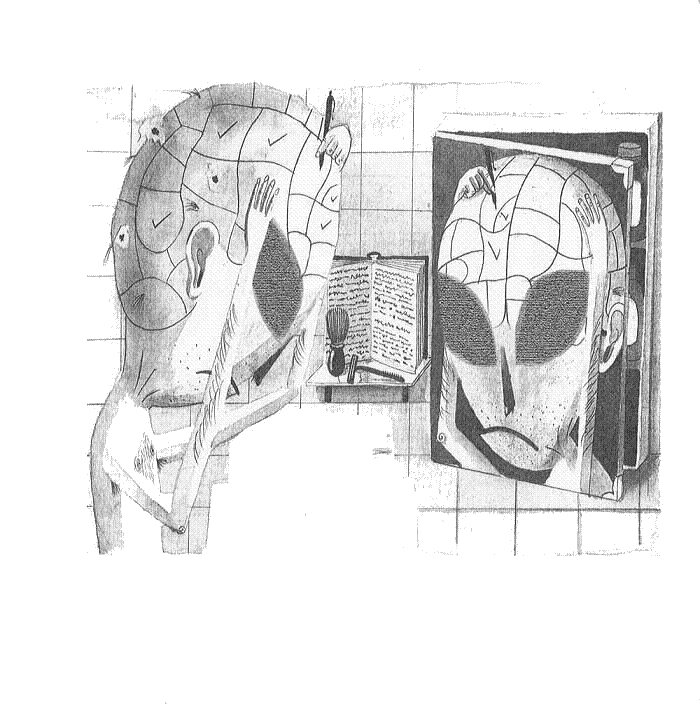
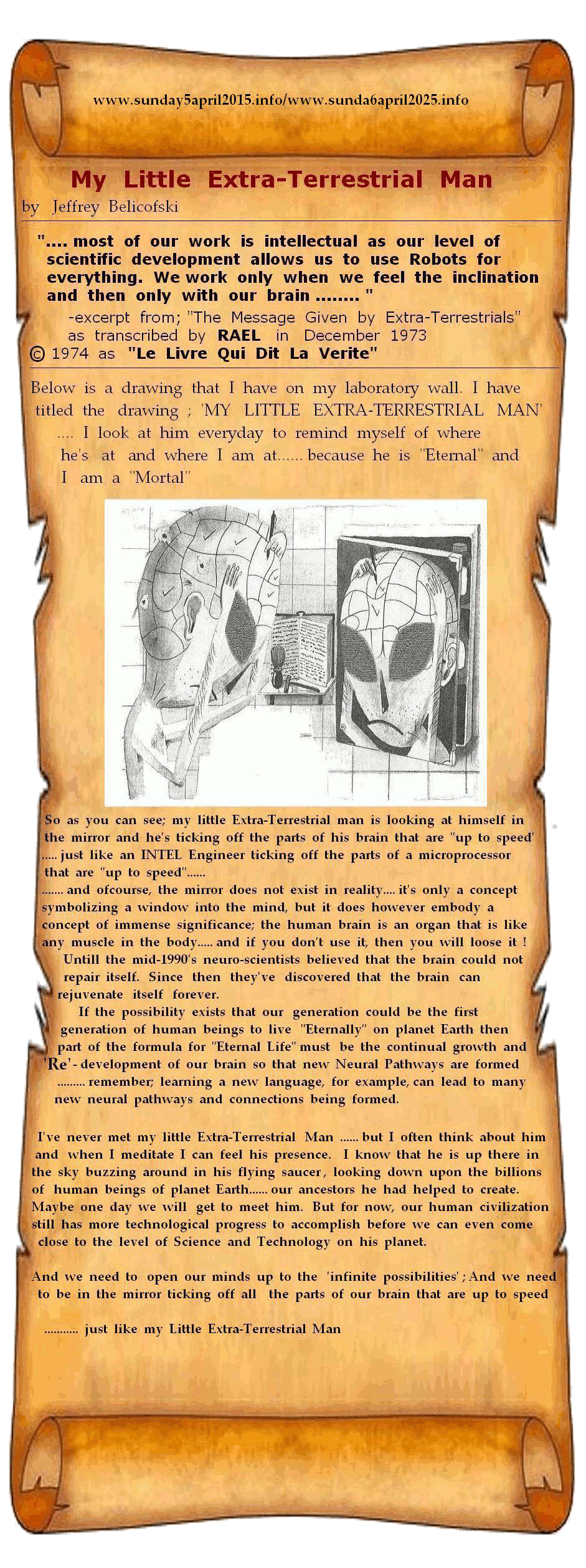

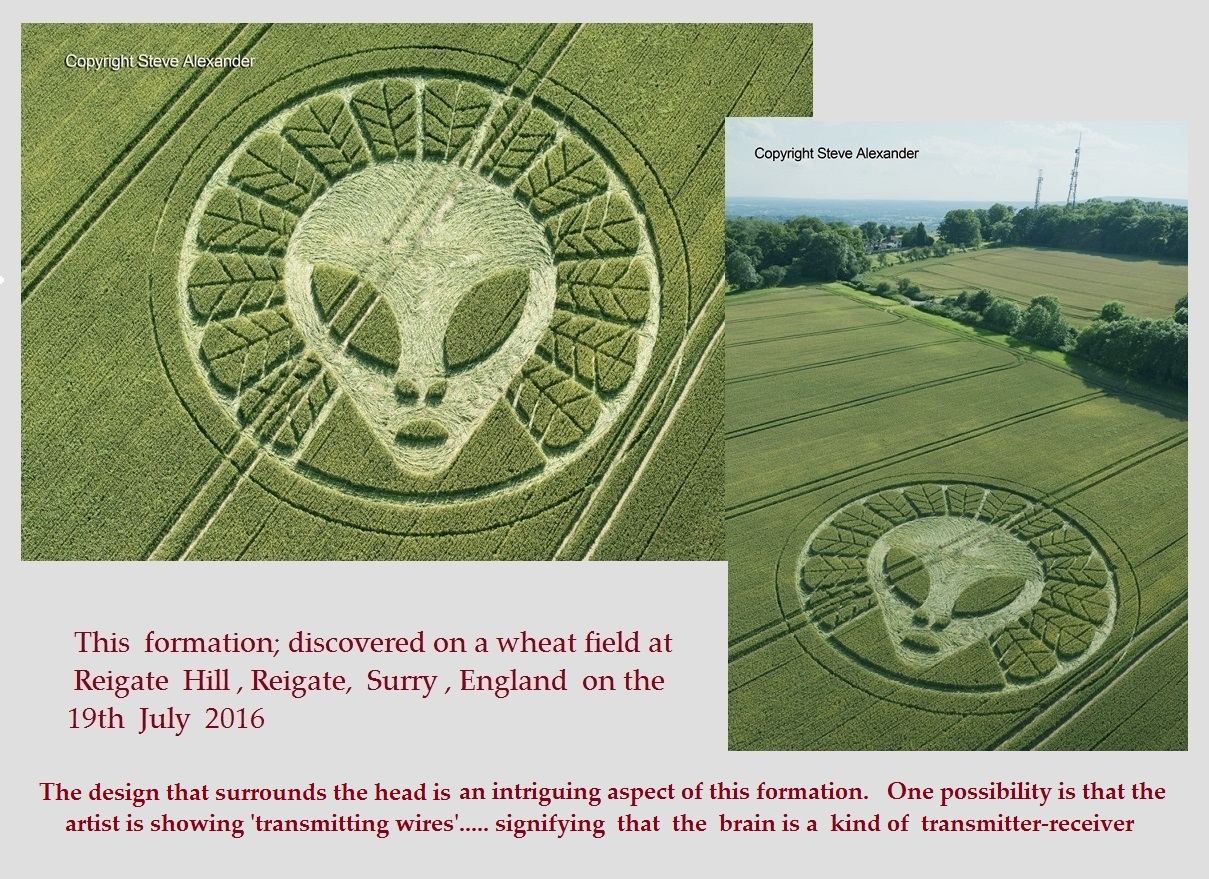
_____________________________________________________________________________________________
For you out there in cyberspace who is yet to develop the faculties of your mind:
These books shown below are excellent resources for you to begin on the path.
These books impart the mental tools used in many areas of Science and Technology.
The Mathematicians whom had developed these mental tools made a great contribution
in that they have given human beings useful and powerful methods to formulate
engineering solutions. These books are excellent resources for many reasons: All
concepts are clearly explained through providing solutions to practical problems.
Each chapter has a multitude of excercizes. The answers to ALL excercises are provided.
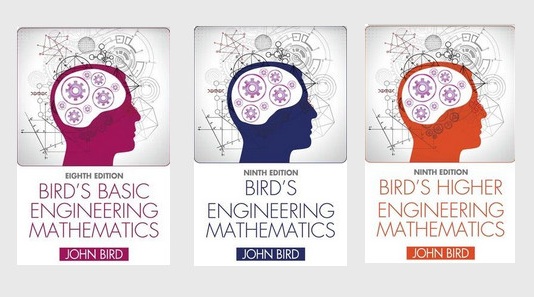
This Book of Life for Mathematics and Science teachers is for these teachers, whom have through their excellent problem solving textbooks; developed the thnking processes of human minds. At this present time there is NOT a webpage that provides a list of these authors: So this book cannot be opened yet.
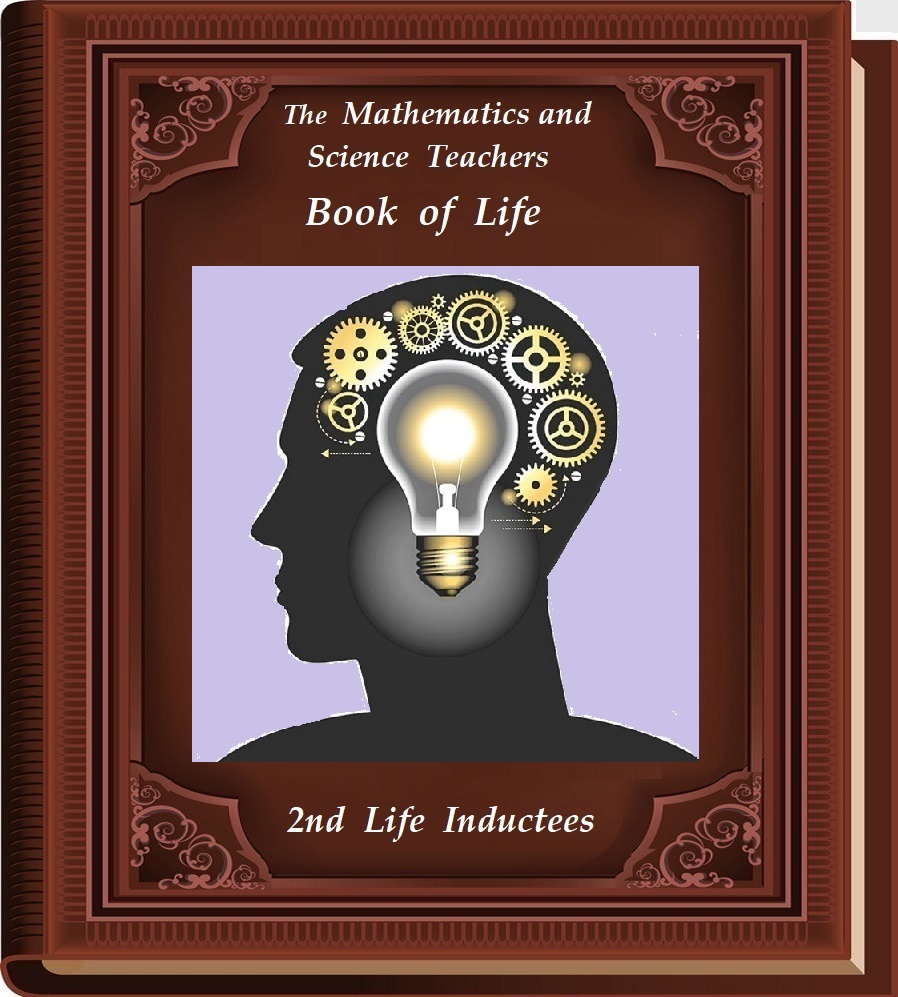
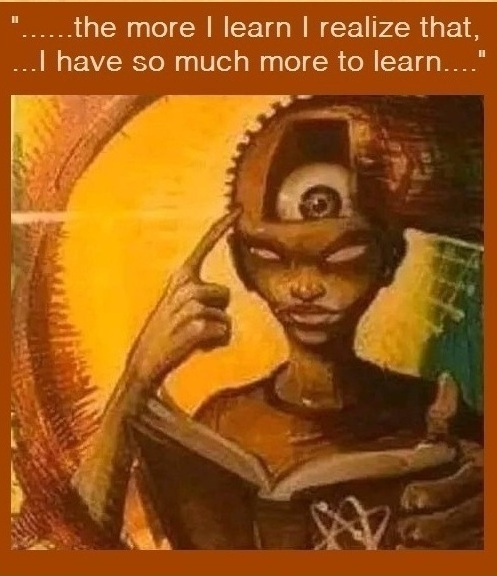
The textbooks shown below teach the basic principles of the Physical Sciences and Engineering. Two points to stress here; FIRSTLY; Technology might continue to evolve but the basic principles of the Physical Sciences, Chemistry and Engineering will never change and no matter how complex technology becomes the underlaying principles that enable it use all the basic principles that are taught in these textbooks. SECONDLY; A clear undertanding of the basic principles of the Physical Sciences, Chemistry and Engineering is essential for one to be able to to modify and invent technology.
Each of these textbooks shown below, that can be downloaded from this website are excellent student resources, references and learning tools for 2 reasons. FIRSTLY; each of these textbooks is excellently written, with excellent diagrams/pictures and SECONDLY; Each of these textbooks has end of chapter exercises.....and most importantly each book also has the answers/solutions to the end of chapter problems. This is absolutely essential in a textbook to be recommended for a student study tool because the student needs to be able to practically apply the concepts and check they have arrived at the correct answer. So for these reasons, the textbooks shown below are excellent resources
A point to note is that although these textbooks can be downloaded from this webpage for free.....it can get tiring concentrating on a computer screen for many hours. So there might be the circumstance when the student decides to purchase a hardcopy of one of these textbook.....and it could be a wise decision in the circumstance.
_______________________________________________________________________________________________________
Algebra and Trigonometry- 2nd Edition by Jay Ambramson
This e-textbook published by Openstax (Rice University) teaches basic Mathematics that's used in all areas of Science and
Engineering. One aspect of this textbook woth mentioning is the way the author explains ( occasionally with Diagrams ) abstract
concepts in way that can be easily understood ; there's no easy way to acquire mathematical tools .......the student needs to
work out solutions to problems and this textbook gives a large selection of end-of-chapter problems with the answers;
Topics include; Radicals ; Polynomials ; Linear equations ; Complex Numbers ; Quadratic Equations : Functions and Graphs:
Logarithmic Functions; Trigonometic Functions; Polar Form of Complex Numbers ; Systems of Equations ; Sequences and Series ;
The Binomial theorem
_______________________________________________________________________________________________________
_______________________________________________________________________________________________________
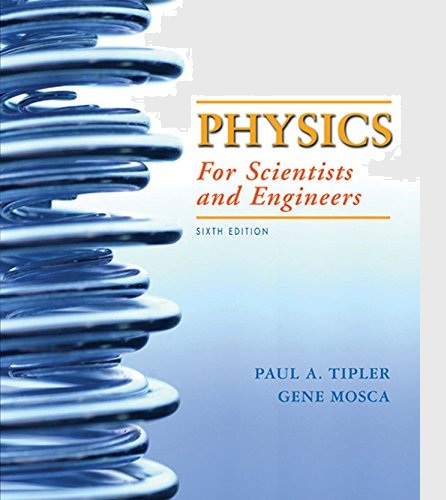 Physics for Scientists and Engineers - 6th Edition by Paul Tipler
This is a general physics textbook that is not only excellently written ; the book also has a number of innovations with
diagrams and pictures. The author applies the concepts he teaches to practical real-world problems. There are
several worked out solutions to problems in each chapter and also a large selection of end-of-chapter problems with answers
to odd numbered problems at the end of the e-textbook. There are specialised end-of-chapter topics explained in
mathematical detail that are not often covered in a textbook on general physics such as wireless communication;
carbon nanotubes; holography; Entropy; energy-level diagrams; Fission and Fusion ; quarks; superconductors and more
Physics for Scientists and Engineers - 6th Edition by Paul Tipler
This is a general physics textbook that is not only excellently written ; the book also has a number of innovations with
diagrams and pictures. The author applies the concepts he teaches to practical real-world problems. There are
several worked out solutions to problems in each chapter and also a large selection of end-of-chapter problems with answers
to odd numbered problems at the end of the e-textbook. There are specialised end-of-chapter topics explained in
mathematical detail that are not often covered in a textbook on general physics such as wireless communication;
carbon nanotubes; holography; Entropy; energy-level diagrams; Fission and Fusion ; quarks; superconductors and more
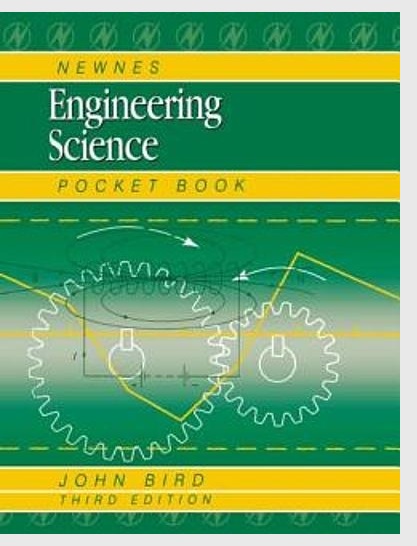 Newnes Engineering Science Pocket Book - 3rd Edition by John Bird
If you've decided to begin a study of the Physics Textbook (shown above) then this comprehensive pocket book is an essential
reference book.....an essential refeence book for students studying one of the different areas of engineering In the 1st
part of this pocket book; the author provides a comprehensive list of all SI units and the conversions between quantities is shown.
Also the author derives many important units. This 1st part also includes a section on basic chemical reactions.
The 2nd part of this pocket book contains formula for many areas of Engineering; Mechanical Engineering including gas-laws;
tensile strength; torque; measurement of pressure and much more ; ......also Electrical Engineering including measuring-instruments;
electrical-machines; transformers; delta-star-transformations; three-phase systems; power-factor; filter-networks and much more
Newnes Engineering Science Pocket Book - 3rd Edition by John Bird
If you've decided to begin a study of the Physics Textbook (shown above) then this comprehensive pocket book is an essential
reference book.....an essential refeence book for students studying one of the different areas of engineering In the 1st
part of this pocket book; the author provides a comprehensive list of all SI units and the conversions between quantities is shown.
Also the author derives many important units. This 1st part also includes a section on basic chemical reactions.
The 2nd part of this pocket book contains formula for many areas of Engineering; Mechanical Engineering including gas-laws;
tensile strength; torque; measurement of pressure and much more ; ......also Electrical Engineering including measuring-instruments;
electrical-machines; transformers; delta-star-transformations; three-phase systems; power-factor; filter-networks and much more
_______________________________________________________________________________________________________
_______________________________________________________________________________________________________
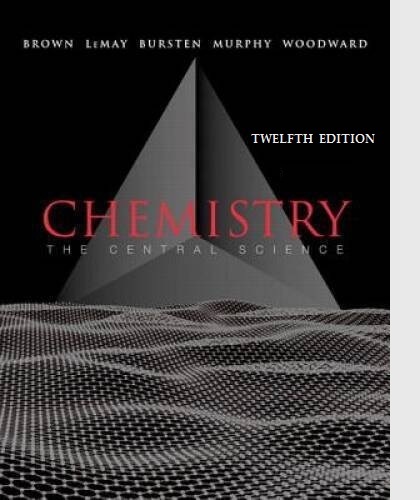 Chemistry _The Central Science- 12th Edition by Brown, Lemay, Bursten
This Chemistry textbook is well known and has been widely used for decades. This textbook has a number of innovations
and also the pictures and diagrams throughout the textbook, used to visualize concepts, are excellent. Expecially
relevant is the way this textbook applies Chemistry to the real world. Each chapter has several worked solutions to
problems with a large number of end-of-chapter problems. The answers are given at the end of the book. Also at
the end of the book is a glosssary of terms used in Chemistry that's arranged in alphabetical order
Chemistry _The Central Science- 12th Edition by Brown, Lemay, Bursten
This Chemistry textbook is well known and has been widely used for decades. This textbook has a number of innovations
and also the pictures and diagrams throughout the textbook, used to visualize concepts, are excellent. Expecially
relevant is the way this textbook applies Chemistry to the real world. Each chapter has several worked solutions to
problems with a large number of end-of-chapter problems. The answers are given at the end of the book. Also at
the end of the book is a glosssary of terms used in Chemistry that's arranged in alphabetical order
_______________________________________________________________________________________________________
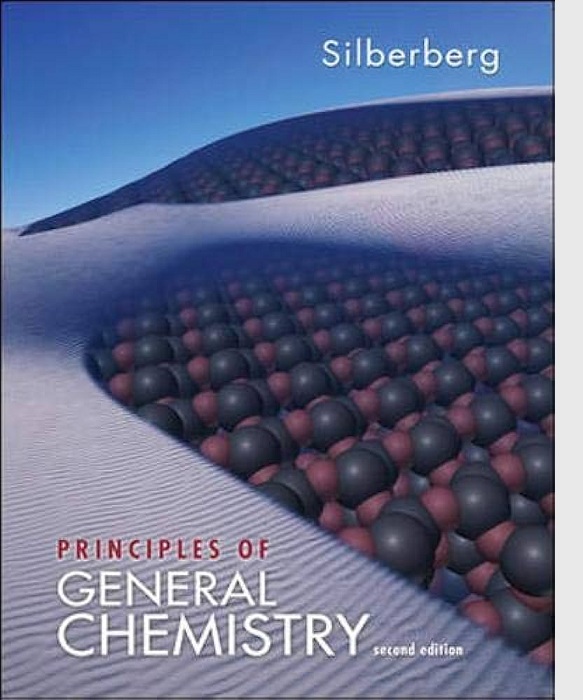 Principles of Chemistry - 2nd Edition by Martin Silberberg
For the student who has already worked their way through the previous introductory chemistry textbook (above ) then this widely
used chemistry textbook will present a challenge. This is also an introductory chemistry textbook however this textbook
focuses on problem solving; teaching the student to plan a logical approach to solving a problem that often requires a
multistep solution. For the student seeking to develop the faculties of their mind in chemistry; then this textbook will
provide the challenge they might be seeking. Each chapter has a multitude of sample problems with solutions. Besides
these there are follow-up problems throughout the chapter. Worked solutions to the follow-up problems appear at the end
of the chapter. Also each chapter has a huge set of end-of-chapter problems and answers to selected problems are
given at the end of the textbook. The diagrams/pictures throughout the textbook are in colour and are of outstanding
quality. This is a very well written textbook
Principles of Chemistry - 2nd Edition by Martin Silberberg
For the student who has already worked their way through the previous introductory chemistry textbook (above ) then this widely
used chemistry textbook will present a challenge. This is also an introductory chemistry textbook however this textbook
focuses on problem solving; teaching the student to plan a logical approach to solving a problem that often requires a
multistep solution. For the student seeking to develop the faculties of their mind in chemistry; then this textbook will
provide the challenge they might be seeking. Each chapter has a multitude of sample problems with solutions. Besides
these there are follow-up problems throughout the chapter. Worked solutions to the follow-up problems appear at the end
of the chapter. Also each chapter has a huge set of end-of-chapter problems and answers to selected problems are
given at the end of the textbook. The diagrams/pictures throughout the textbook are in colour and are of outstanding
quality. This is a very well written textbook
_______________________________________________________________________________________________________
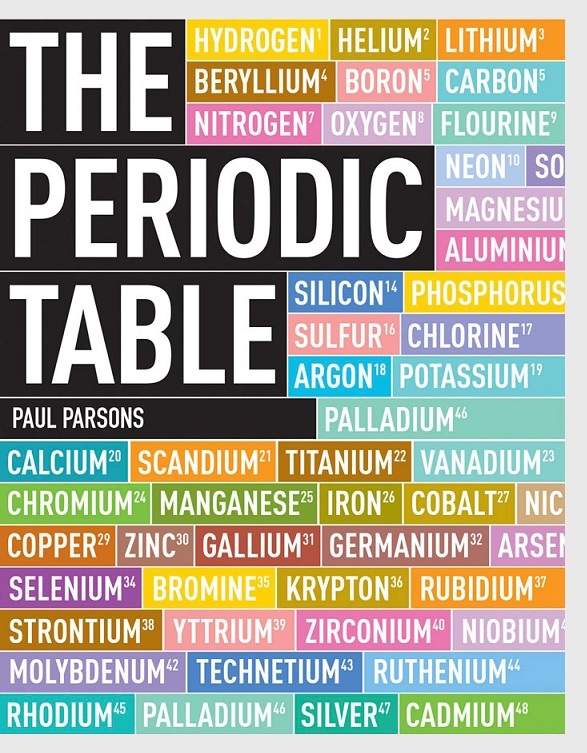 The Periodic Table; Field Guide to the Elements by Paul Pearsons and Gail Dixon
If you intend to study the Chemistry textooks shown above then this reference book of all the known chemical elements
is essential reading; the qualities of each element are described along with it's melting point; boiling point; crystal structure;
and atomic weight. The history behind the discovery of the element is explained, and also the uses of the element.
The arrangement of the Periodic Table is also explained. For a chemistry student this book is a masterpiece and an
excellent reference book
The Periodic Table; Field Guide to the Elements by Paul Pearsons and Gail Dixon
If you intend to study the Chemistry textooks shown above then this reference book of all the known chemical elements
is essential reading; the qualities of each element are described along with it's melting point; boiling point; crystal structure;
and atomic weight. The history behind the discovery of the element is explained, and also the uses of the element.
The arrangement of the Periodic Table is also explained. For a chemistry student this book is a masterpiece and an
excellent reference book
_______________________________________________________________________________________________________
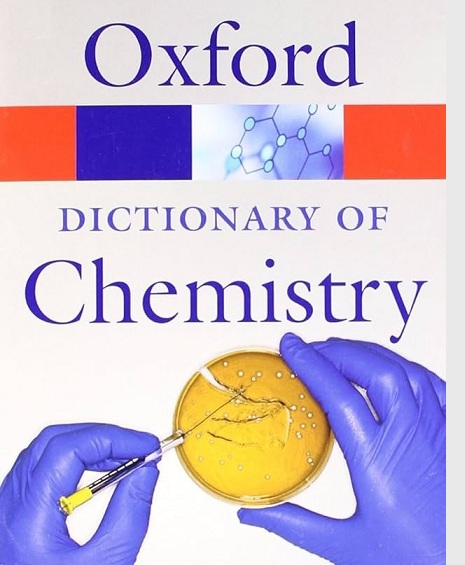 Oxord Dictionary of Chemistry Edited by John Daintith
This Dictionary of Chemistry is arranged in alphabetical chapters; each entry is explained with
diagrams showing chemical structures and chemical formulas where necessary. Terms from all branches of
Chemistry are covered; Biochemistry, Physical Chemistry, Inorganic and organic Chemstry; Nuclear Chemistry
Forensic Chemistry, Metallurgy and Chemoinformatics. This dictionary is excellently written.......
both clear and concise.
Oxord Dictionary of Chemistry Edited by John Daintith
This Dictionary of Chemistry is arranged in alphabetical chapters; each entry is explained with
diagrams showing chemical structures and chemical formulas where necessary. Terms from all branches of
Chemistry are covered; Biochemistry, Physical Chemistry, Inorganic and organic Chemstry; Nuclear Chemistry
Forensic Chemistry, Metallurgy and Chemoinformatics. This dictionary is excellently written.......
both clear and concise.
_______________________________________________________________________________________________________
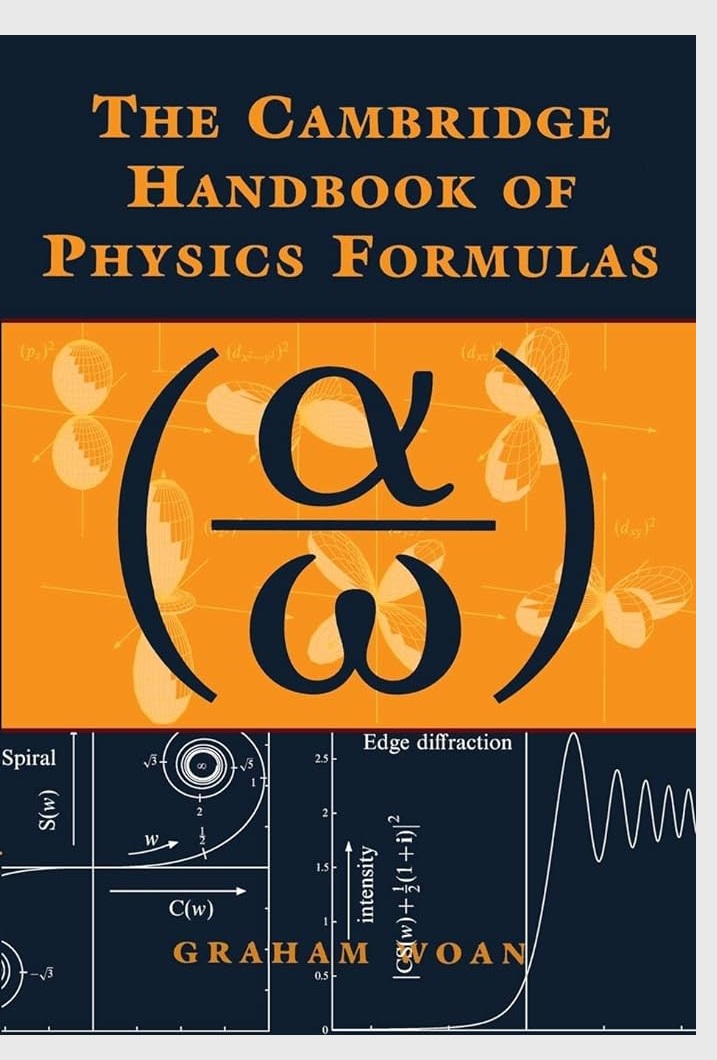 The Cambridge Handbook of Physics Formula by Graham Woan
If you intend to study the Physics textbook shown above then this reference book will be useful --- this is a quick reference
for students in Physics and Engineering which contains over 2000 useful formulas and equations in all areas of Physics;
Mechanics; Quantum Physics; Thermodynamics; Solid State Physics; Electromagnetism; Optics; Astrophysics; and also essential
mathematical formulas. All Physical constants are given and also a list of all SI units and temperature conversions.
The Cambridge Handbook of Physics Formula by Graham Woan
If you intend to study the Physics textbook shown above then this reference book will be useful --- this is a quick reference
for students in Physics and Engineering which contains over 2000 useful formulas and equations in all areas of Physics;
Mechanics; Quantum Physics; Thermodynamics; Solid State Physics; Electromagnetism; Optics; Astrophysics; and also essential
mathematical formulas. All Physical constants are given and also a list of all SI units and temperature conversions.
_______________________________________________________________________________________________________
___________________________________________________________________________________________________________________________
Electrical and Electronic Technology - 10th Edition by Edward Hughes
Electrical and Electronic Technology by Hughes was first published in England in 1960, with the title Electrical Technology
This textbook has been improved over 10 editions and now this 10th edition covers all the basic principles of electrical
circuits and electrical machines and also electronic circuits and solid state devices. This is a well known and widely used textbook.
The circuit diagrams and the explanations to the operation of basic circuits is excellent. Besides electrical machines and
transformers, the textbook covers all basic electronic circuits; rectifiers; passive-filters; power electronics; FET amplifiers;
D/A converters; digital fundamentals; signals and systems including convolution and de-convolution, and much more.
The end-of-chapter exercises require the student to apply the concepts taught in the chapter and answers to all excercises are given
at the end of the e-book. This 10th edition is outstanding as a student resource
_______________________________________________________________________________________________________
 Electrical Circuit Theory and Technology - 3rd Edition by John Bird
This is another textbook that teaches the basics of electrical technology and electrical circuit analysis with derivations
to all essential formulae that are clear and concise. The textbook begins by teaching the units associated with electrical quantities;
Power and Energy; Ohm's law and electrical measuring instruments. Onwards, the textbook teaches fundamental principles; basic circuits;
A.C. voltages and current; Single-phase and Three-phase circuits; Transformers; D.C Machines; Three-phase induction motors; A.C. Bridges;
Attenuators; Filter Networks and much more. There are also chapters on semiconductor devices; transistors and more. This is an excellent
problem book and ALL answers are given to the end-of-chapter problems. Within the 45 chapters of this textbook are all the basics of Electrcial
and Electronic Technology
Electrical Circuit Theory and Technology - 3rd Edition by John Bird
This is another textbook that teaches the basics of electrical technology and electrical circuit analysis with derivations
to all essential formulae that are clear and concise. The textbook begins by teaching the units associated with electrical quantities;
Power and Energy; Ohm's law and electrical measuring instruments. Onwards, the textbook teaches fundamental principles; basic circuits;
A.C. voltages and current; Single-phase and Three-phase circuits; Transformers; D.C Machines; Three-phase induction motors; A.C. Bridges;
Attenuators; Filter Networks and much more. There are also chapters on semiconductor devices; transistors and more. This is an excellent
problem book and ALL answers are given to the end-of-chapter problems. Within the 45 chapters of this textbook are all the basics of Electrcial
and Electronic Technology
_______________________________________________________________________________________________________
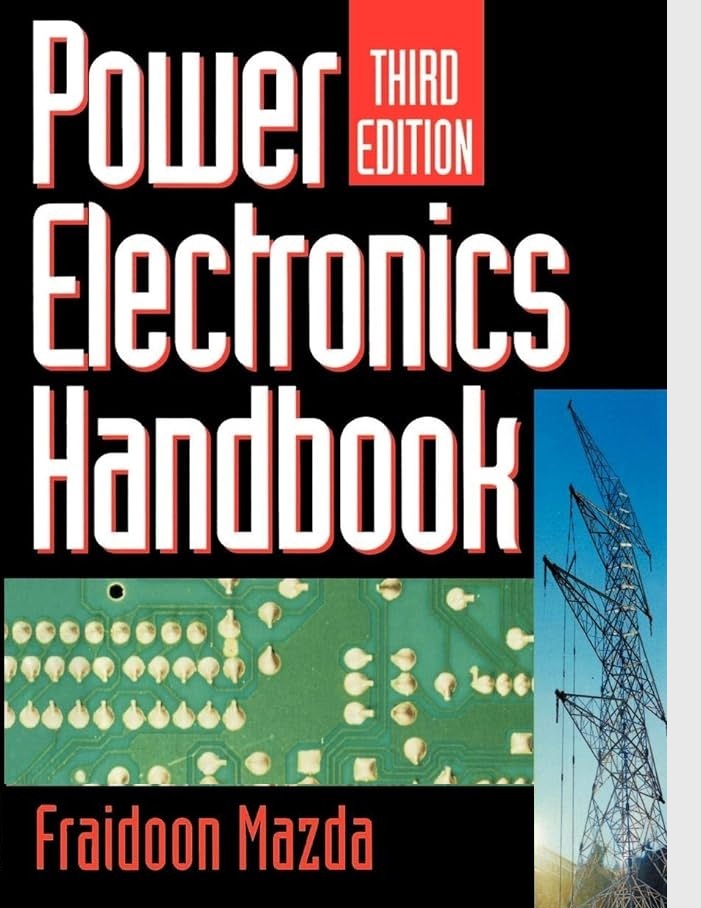 Power Electronics Handbook - 3rd Edition by Fraidoon Mazda
For the student who is serious about embarking on this journey into circuit design then this Power Electronics Handbook
is a useful reference .....and it is a "reference book " and NOT a textbook. A variety of power electronic circuits are explained
including both 3-phase and single phase power electronic circuits. This handbook begins with a detailed summary of semiconductor devices
used to build these circuits such as; Bipolar transistors; Thyristors; Triacs; and voltage-reference-diodes. Then many circuits are
covered starting with basic rectifiers and then A.C.-frequency-converters; push-pull and bridge Inverters; voltage multipliers; and many more.
The graphs showing both output voltage amplitude and phase are excellent.
Power Electronics Handbook - 3rd Edition by Fraidoon Mazda
For the student who is serious about embarking on this journey into circuit design then this Power Electronics Handbook
is a useful reference .....and it is a "reference book " and NOT a textbook. A variety of power electronic circuits are explained
including both 3-phase and single phase power electronic circuits. This handbook begins with a detailed summary of semiconductor devices
used to build these circuits such as; Bipolar transistors; Thyristors; Triacs; and voltage-reference-diodes. Then many circuits are
covered starting with basic rectifiers and then A.C.-frequency-converters; push-pull and bridge Inverters; voltage multipliers; and many more.
The graphs showing both output voltage amplitude and phase are excellent.
_______________________________________________________________________________________________________
_______________________________________________________________________________________________________
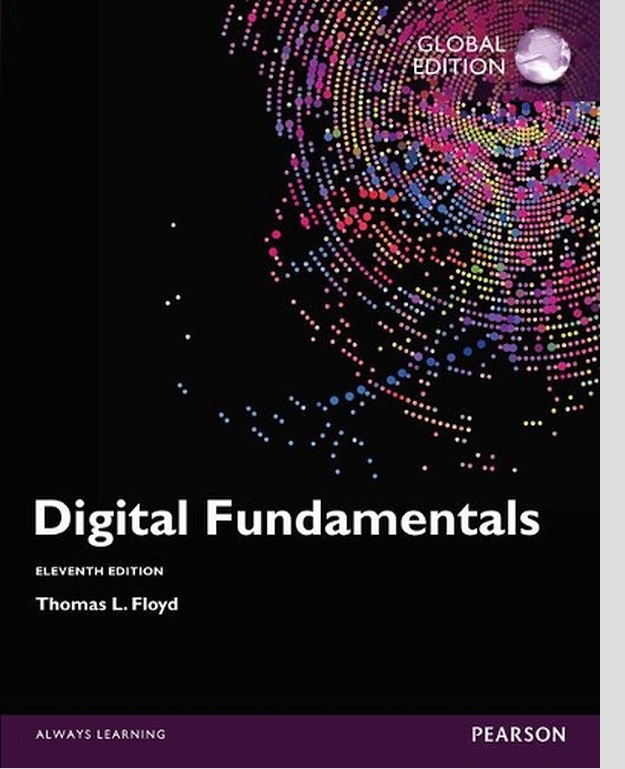 Digital Electronics - 11th (Global) Edition by Thomas Floyd
This widely used textbook is now in it's 11th edition This "Global" edition has a number of features
to it that make it an excellent student resource; All the basic building blocks of Digital Electronic Circuits are
comprehensively covered so to teach the core fundamentals of the subject. Every chapter ends with a list of key terms
and also end-of-chapter problems and answers to odd numbered problems are given at the end of the book. This textbook
is in colour; the typeset and pictures are excellent
Digital Electronics - 11th (Global) Edition by Thomas Floyd
This widely used textbook is now in it's 11th edition This "Global" edition has a number of features
to it that make it an excellent student resource; All the basic building blocks of Digital Electronic Circuits are
comprehensively covered so to teach the core fundamentals of the subject. Every chapter ends with a list of key terms
and also end-of-chapter problems and answers to odd numbered problems are given at the end of the book. This textbook
is in colour; the typeset and pictures are excellent
_______________________________________________________________________________________________________
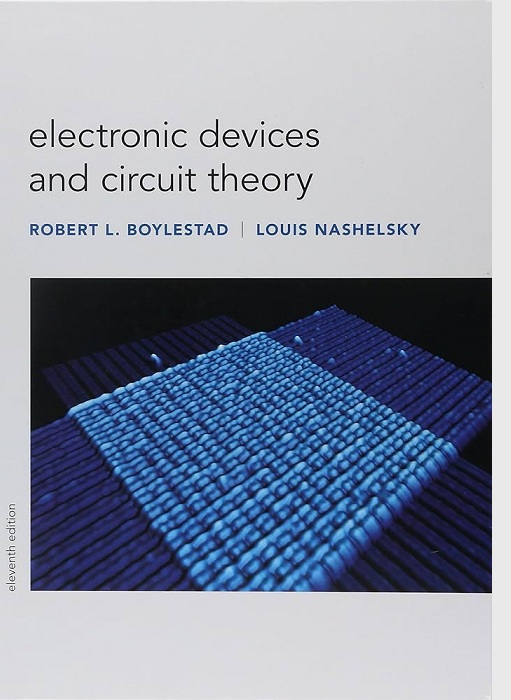 Electronic Devices and Circuits - 11th Edition by Robert Boylestad and Louis Nashelsky
This is another widely used textbook that is also in it's 11th edition. This textbook teaches the fundamentals
of electronic devices and circuit configurations for these devices such as BJT transistors and amplifiers; FET transistors and amplifiers;
Operational Amplifiers; basic Oscillator circuits and the fundamentals of feedback; there is also a chapter on power supplies. The
textbook also has a chapter on novel 2-terminal devices featuring a comprehensive section on the Schottky diode and Varactor diode and other
2-terminal devices and there is also a chapter on SCR's; Triacs and other pnpn devices. Each chapter has a large set of end-of-chapter problems ....
....answers to odd-numbers problems are at the end of the book. The diagrams throughout the textbook are detailed as the text goes into
a detailed explanation of device operation
Electronic Devices and Circuits - 11th Edition by Robert Boylestad and Louis Nashelsky
This is another widely used textbook that is also in it's 11th edition. This textbook teaches the fundamentals
of electronic devices and circuit configurations for these devices such as BJT transistors and amplifiers; FET transistors and amplifiers;
Operational Amplifiers; basic Oscillator circuits and the fundamentals of feedback; there is also a chapter on power supplies. The
textbook also has a chapter on novel 2-terminal devices featuring a comprehensive section on the Schottky diode and Varactor diode and other
2-terminal devices and there is also a chapter on SCR's; Triacs and other pnpn devices. Each chapter has a large set of end-of-chapter problems ....
....answers to odd-numbers problems are at the end of the book. The diagrams throughout the textbook are detailed as the text goes into
a detailed explanation of device operation
_______________________________________________________________________________________________________
_______________________________________________________________________________________________________
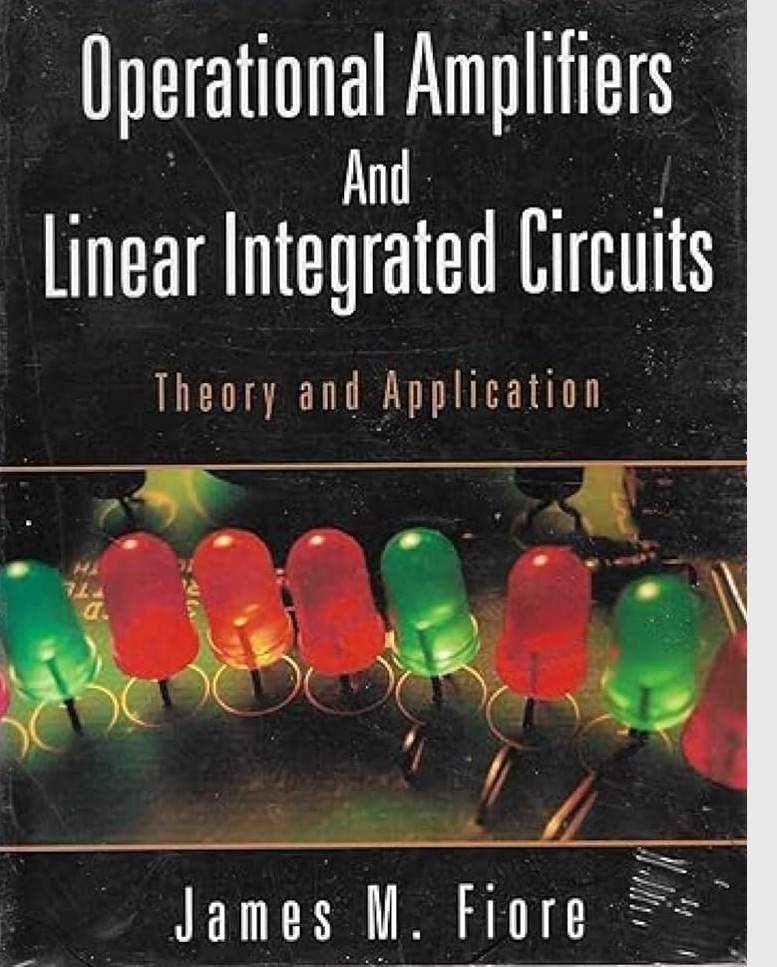 Operational Amplifiers and Linear Integrated Circuits - 3rd Edition by James Fiore
This textbook teaches all the basic building block circuits that use the operational amplifier, and also
integrated circuits that are built from operational amplifiers. The author shows a multitude of op-mp circuits in each chapter and
derives equations used to select components that will give the desired output. The textbook is well written and all the authors
derivations are easy to follow. Each chapter ends with a set of review questions and also a set of problems. Answers to the
review questions and to the end-of-chapter problems are at the end of the book. The author has included manufacturers data sheets
and with the many additional topics related to op-amps make this textbook an excellent student resource
Operational Amplifiers and Linear Integrated Circuits - 3rd Edition by James Fiore
This textbook teaches all the basic building block circuits that use the operational amplifier, and also
integrated circuits that are built from operational amplifiers. The author shows a multitude of op-mp circuits in each chapter and
derives equations used to select components that will give the desired output. The textbook is well written and all the authors
derivations are easy to follow. Each chapter ends with a set of review questions and also a set of problems. Answers to the
review questions and to the end-of-chapter problems are at the end of the book. The author has included manufacturers data sheets
and with the many additional topics related to op-amps make this textbook an excellent student resource
_______________________________________________________________________________________________________
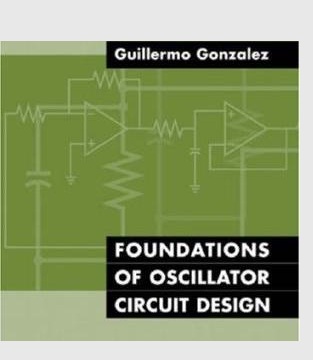 Foundations of Oscillator Circuit Design by Guillermo Gonzales
If you intend to study the topic in the book above; ( operational amplifiers and linear IC's ) then this book
on oscillator circuit is valuable......this is NOT a textbook with review questions and end-of-chapter exercises However,
this is an excellent reference book that teaches the theory and design of the many different types of these basic building blocks;
The author derives formula for selecting components in many design examples that he has shown.
The typeset is excellent, the derivations are easy to follow and the author covers a multitude of oscillator circuits that are
well known and also novel.
Foundations of Oscillator Circuit Design by Guillermo Gonzales
If you intend to study the topic in the book above; ( operational amplifiers and linear IC's ) then this book
on oscillator circuit is valuable......this is NOT a textbook with review questions and end-of-chapter exercises However,
this is an excellent reference book that teaches the theory and design of the many different types of these basic building blocks;
The author derives formula for selecting components in many design examples that he has shown.
The typeset is excellent, the derivations are easy to follow and the author covers a multitude of oscillator circuits that are
well known and also novel.
_______________________________________________________________________________________________________
 Active Filter Design by Allan Waters
If you intend to study the topic in the book above; ( operational amplifiers and linear IC's ) then this book
on Active Filter Design is valuable. The author begins by explaining the basic concept of electronic filtering and showing
the basic low-pass, high-pass, band-pass, band-reject, and all-pass filters. From there the author provides an analysis of
a multitude of basic filter circuits using the operational amplifier ....... and then onto complex filter circuits that also use the
operational amplifier. All the design equations the author uses he derives, and his derivations are easy to follow. In each
chapter many filters are designed; completed circuits are shown together with graphs of the output response. Each chapter
has end-of-chapter problems with the answers
Active Filter Design by Allan Waters
If you intend to study the topic in the book above; ( operational amplifiers and linear IC's ) then this book
on Active Filter Design is valuable. The author begins by explaining the basic concept of electronic filtering and showing
the basic low-pass, high-pass, band-pass, band-reject, and all-pass filters. From there the author provides an analysis of
a multitude of basic filter circuits using the operational amplifier ....... and then onto complex filter circuits that also use the
operational amplifier. All the design equations the author uses he derives, and his derivations are easy to follow. In each
chapter many filters are designed; completed circuits are shown together with graphs of the output response. Each chapter
has end-of-chapter problems with the answers
_______________________________________________________________________________________________________
 Active Filters ; Theory and Design by S. Pactitis
This textbook teaches the design of active filters. The textbook begins by explaining the basic filter types by
showing frequency response graphs and giving basic terminology. From there onwards the author synthesizes well known filter
circuits using the op-amp and he shows methods for synthesizing an active filter using a specific type of acive filter to get
a specific frequency response. Each chapter has several design examples. There is however, a negative aspect to this textbook:
No answers are given to the end-of-chapter exercises. Thus, I'm recommending this textbook with some apprehension, but considering the
excellent features of the textbook such as the clarity of the authors derivations of the frequency response of his circuits....... I add
this textbook to the collection
Active Filters ; Theory and Design by S. Pactitis
This textbook teaches the design of active filters. The textbook begins by explaining the basic filter types by
showing frequency response graphs and giving basic terminology. From there onwards the author synthesizes well known filter
circuits using the op-amp and he shows methods for synthesizing an active filter using a specific type of acive filter to get
a specific frequency response. Each chapter has several design examples. There is however, a negative aspect to this textbook:
No answers are given to the end-of-chapter exercises. Thus, I'm recommending this textbook with some apprehension, but considering the
excellent features of the textbook such as the clarity of the authors derivations of the frequency response of his circuits....... I add
this textbook to the collection
_______________________________________________________________________________________________________
 Electronic Filter Design Handbook by Arthur Williams and Fred Taylor
This widely used handbook of electronic filter design is now in it's 4th Edition. The handbook begins
with an introduction to the theory behind LC networks; the Pole-Zero concept and synthesizing filters from polynomials using
both passive and active filters as examples. Then the handbook explains frequency response characteristics using LC filter
examples. Onwards, the handbook teaches all the techniques to design active, pssive and digital filters. There is
a chapter that covers each of the main filter types; low-pass; high-pass; band-pass; band-reject; switched capacitor filters
and microwave filters. There is also a chapter that teaches refinements in LC filter design and a section that teaches digital
filter mathematics. With all the unique features this handbook is very useful for the student who is serious about learning
filter design
Electronic Filter Design Handbook by Arthur Williams and Fred Taylor
This widely used handbook of electronic filter design is now in it's 4th Edition. The handbook begins
with an introduction to the theory behind LC networks; the Pole-Zero concept and synthesizing filters from polynomials using
both passive and active filters as examples. Then the handbook explains frequency response characteristics using LC filter
examples. Onwards, the handbook teaches all the techniques to design active, pssive and digital filters. There is
a chapter that covers each of the main filter types; low-pass; high-pass; band-pass; band-reject; switched capacitor filters
and microwave filters. There is also a chapter that teaches refinements in LC filter design and a section that teaches digital
filter mathematics. With all the unique features this handbook is very useful for the student who is serious about learning
filter design
_______________________________________________________________________________________________________
_______________________________________________________________________________________________________
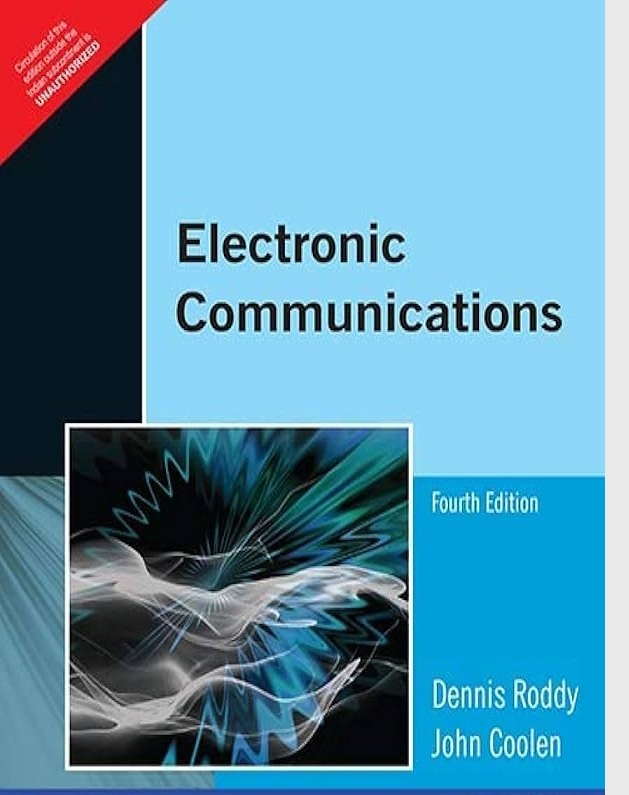 Electronic Communications - 4th Edition by Dennis Roddy and John Coolen
This widely used textbook which was first published in 1980 is now in it's 4th Edition ( as of 2014) .
This is a textbook that teaches the Science of telecommunications; the operation of many types of circuits is explained
including Receivers; Mixers; Tuned-amplifiers; Oscillators; Active-Filters and more. There is a chapter on Digital
Communications and Antennas and more. This comprehensive textbook is an excellent student resource, but there is, however,
one negative aspect to it. Each chapter ends with a large set of problems but there are NO answers given to any of these
end-of-chapter problems For this reason, this textbook is most ideal for a classroom: where the lecturer has the solutions
manual and they can explain solutions to some of the end-of-chapter problems. In each chapter, the authors provide worked
solutions to several design exercises. This textbook is excellent for the student who is interested in learning how the
techniques of circuit analysis are practically applied
Electronic Communications - 4th Edition by Dennis Roddy and John Coolen
This widely used textbook which was first published in 1980 is now in it's 4th Edition ( as of 2014) .
This is a textbook that teaches the Science of telecommunications; the operation of many types of circuits is explained
including Receivers; Mixers; Tuned-amplifiers; Oscillators; Active-Filters and more. There is a chapter on Digital
Communications and Antennas and more. This comprehensive textbook is an excellent student resource, but there is, however,
one negative aspect to it. Each chapter ends with a large set of problems but there are NO answers given to any of these
end-of-chapter problems For this reason, this textbook is most ideal for a classroom: where the lecturer has the solutions
manual and they can explain solutions to some of the end-of-chapter problems. In each chapter, the authors provide worked
solutions to several design exercises. This textbook is excellent for the student who is interested in learning how the
techniques of circuit analysis are practically applied
_______________________________________________________________________________________________________
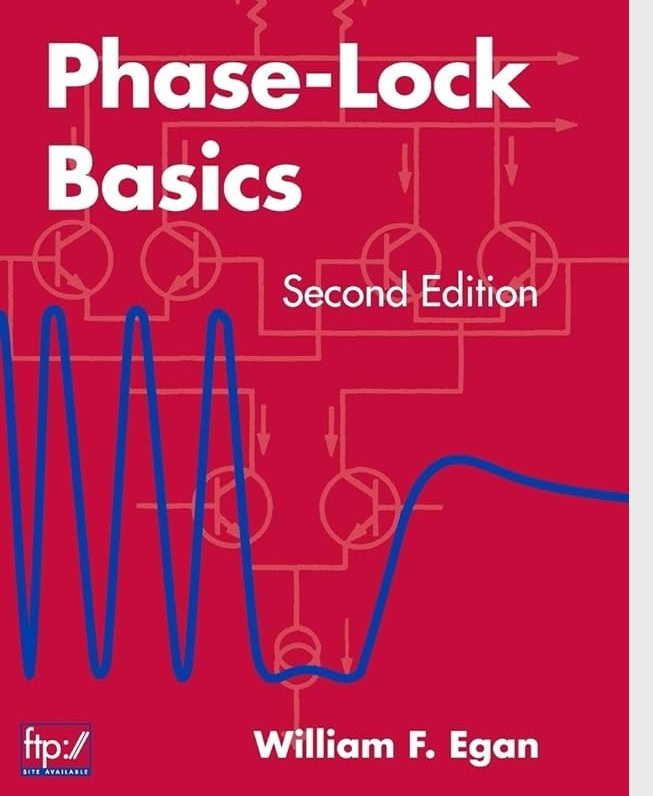 Phse Lock Loop Basics - 2nd Edition by William Egan
This is an exeptionally well written textbook on the subject of Phase Locked Loops for the student
who is serious about understanding electronic communication circuitry from a design point of view. The textbook begins
teaching this basic building block by developing a basic understanding of it's operation and the three main components of
which the Phase-Locked-Loop comprises. The author had been teaching phase-locked-loops at Santa Clara University in
California for several years. After the author explains the basic operation and then the
response from a phase-detector ......he moves onto teach the basic loop; loop stability; modulation-response and then onto
advanced topics. Each chapter has design examples (using practical circuits) with worked solutions.
Phse Lock Loop Basics - 2nd Edition by William Egan
This is an exeptionally well written textbook on the subject of Phase Locked Loops for the student
who is serious about understanding electronic communication circuitry from a design point of view. The textbook begins
teaching this basic building block by developing a basic understanding of it's operation and the three main components of
which the Phase-Locked-Loop comprises. The author had been teaching phase-locked-loops at Santa Clara University in
California for several years. After the author explains the basic operation and then the
response from a phase-detector ......he moves onto teach the basic loop; loop stability; modulation-response and then onto
advanced topics. Each chapter has design examples (using practical circuits) with worked solutions.
_______________________________________________________________________________________________________
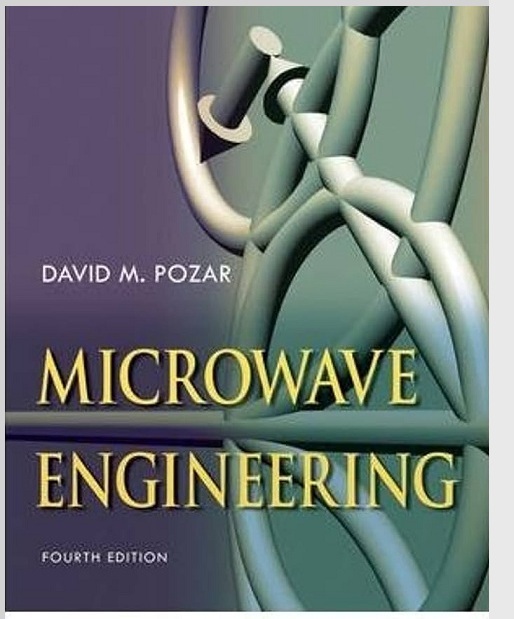 Microwave Engineering by David Pozar
This textbook teaches the Science of Microwave Engineering as it's applied to microwave communications
and Radar. The textbook begins with a history of Microwave Engineering and then explains Maxwell's equations
and from there builds the mathematical basis for this branch of Engineering, including the wave equation and polarized waves,
and from there onwards many types of microwave resonant circuits are analyzed and also microwave-oscillators, microwave-mixers,
frequency multipliers and more. Many types of solid-state devices are explained. This textbook provies an
in-depth comprehensive study of this branch of Engineering There are end-of-chapter problems. There are only answers
to a few of these problems at the end of the book.....however, there is a solutions manual for the textbook and I've included
it below
Microwave Engineering by David Pozar
This textbook teaches the Science of Microwave Engineering as it's applied to microwave communications
and Radar. The textbook begins with a history of Microwave Engineering and then explains Maxwell's equations
and from there builds the mathematical basis for this branch of Engineering, including the wave equation and polarized waves,
and from there onwards many types of microwave resonant circuits are analyzed and also microwave-oscillators, microwave-mixers,
frequency multipliers and more. Many types of solid-state devices are explained. This textbook provies an
in-depth comprehensive study of this branch of Engineering There are end-of-chapter problems. There are only answers
to a few of these problems at the end of the book.....however, there is a solutions manual for the textbook and I've included
it below
_______________________________________________________________________________________________________
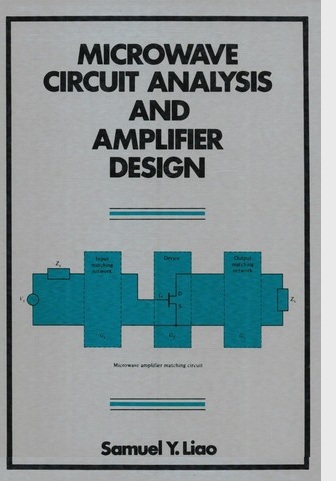 Microwave Circuit Analysis and Amplifier Design by Samuel Y. Liao
This textbook (published in 1987) teaches the design techniques of microwave amplifiers and oscillators. This textbook has a number of
features that make it a useful student resource: The author begins by defining the microwave band of frequencies and also gives some
history of the development of microwave and radar engineering. Then transmission lines; matching techniques and the Smith Chart are
taught. Onwards the design of microwave amplifiers and oscillators are taught including high-power-oscillator design;
broadband oscillator design; Gunn-diode-oscillator design and IMPATT-oscillator design. Each chapter contains worked design examples.
There are end-of-chapter problems but NO answers are given in the textbook.
Microwave Circuit Analysis and Amplifier Design by Samuel Y. Liao
This textbook (published in 1987) teaches the design techniques of microwave amplifiers and oscillators. This textbook has a number of
features that make it a useful student resource: The author begins by defining the microwave band of frequencies and also gives some
history of the development of microwave and radar engineering. Then transmission lines; matching techniques and the Smith Chart are
taught. Onwards the design of microwave amplifiers and oscillators are taught including high-power-oscillator design;
broadband oscillator design; Gunn-diode-oscillator design and IMPATT-oscillator design. Each chapter contains worked design examples.
There are end-of-chapter problems but NO answers are given in the textbook.
_______________________________________________________________________________________________________
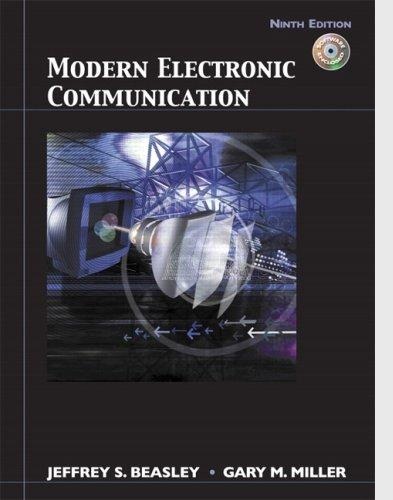 Modern Electronic Communication by Jeffrey Beasley and Gary Miller
The textbook teaches the basic principles and circuit operation for many different types of communication systems.
The textbook appears to be directed towards the student studying to be a technician who will be maintaining/troubleshooting
different types of communications equipment, but it could be used by any student who wants to get an insight into the circuit operation
of different types communication systems.....many different types of circuits are analyzed. Each chapter features a troubleshooting
section. The textbook is excellently written; the diagrams throughout the textbook are excellent......and each chapter ends with a
large number of questions and problems. Numerical answers given
Modern Electronic Communication by Jeffrey Beasley and Gary Miller
The textbook teaches the basic principles and circuit operation for many different types of communication systems.
The textbook appears to be directed towards the student studying to be a technician who will be maintaining/troubleshooting
different types of communications equipment, but it could be used by any student who wants to get an insight into the circuit operation
of different types communication systems.....many different types of circuits are analyzed. Each chapter features a troubleshooting
section. The textbook is excellently written; the diagrams throughout the textbook are excellent......and each chapter ends with a
large number of questions and problems. Numerical answers given
_______________________________________________________________________________________________________
_______________________________________________________________________________________________________
The Encyclopedia of Electronic Circuits contains the largest treasure-trove of circuits that are available anywhere --- and there are many different types of circuits for many different applications. Volumes 4 and 5 are poor quality scans but the component specifications are still discernable. Volume 7 is a high resolution scan that is excellent quality....however, the file size would be so huge that it had to be scanned in 6 separate partitions. The 6 separate Pdf's that comprise Volume 7 of the Encyclopedia of Electronic Circuits are available on a separate webpage.....this webpage can be reached by clicking onto the Pdf-link below.
Volume 7 contains the most useful circuits ; this volume contains over 1000 circuits sourced from popular Electronics Magazines....and organized into 117 Chapters. Volume 7 was published in the late 1990's. Also included below is a document that teaches the etching of copper foil boards to make circuit boards
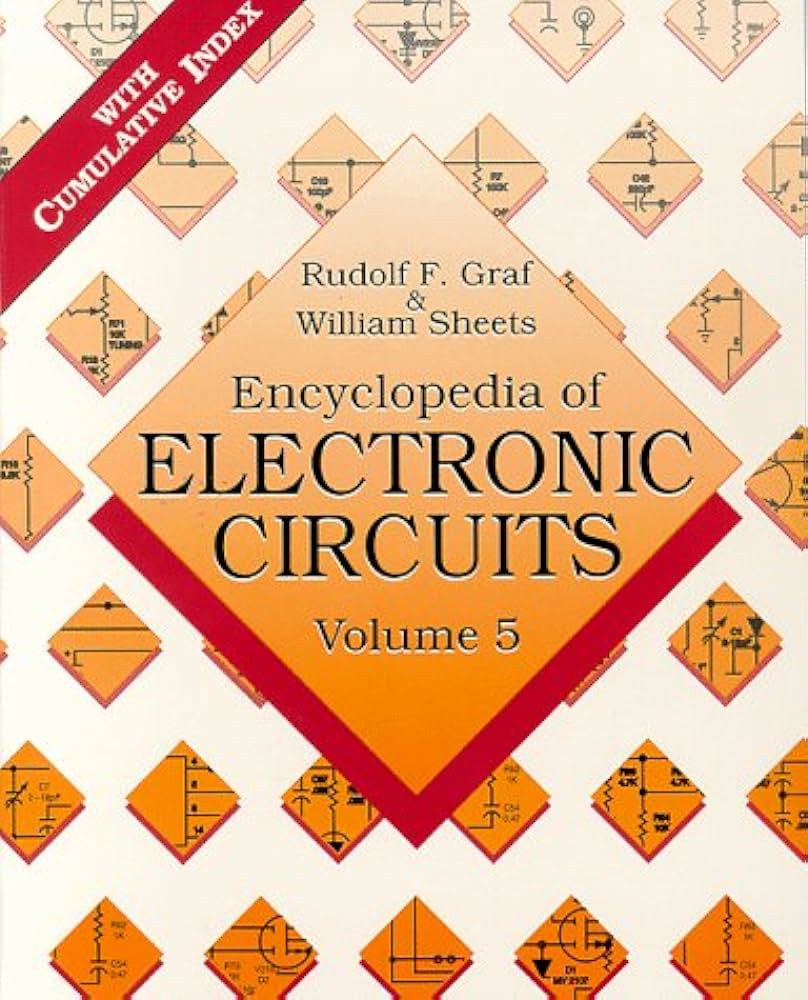
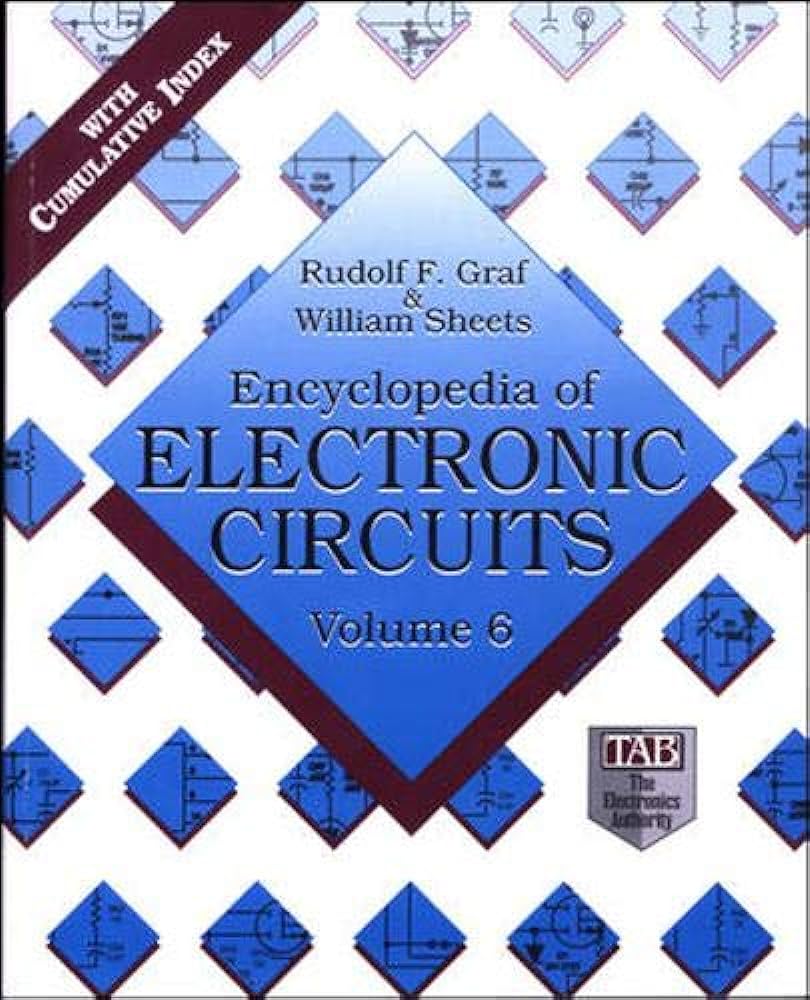
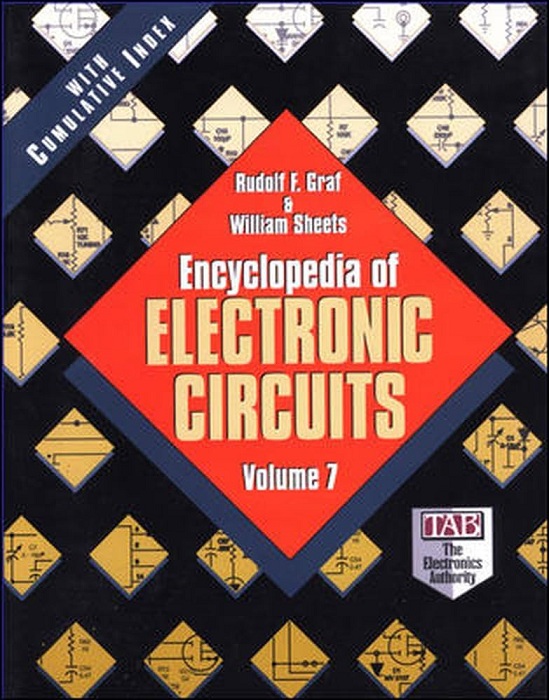
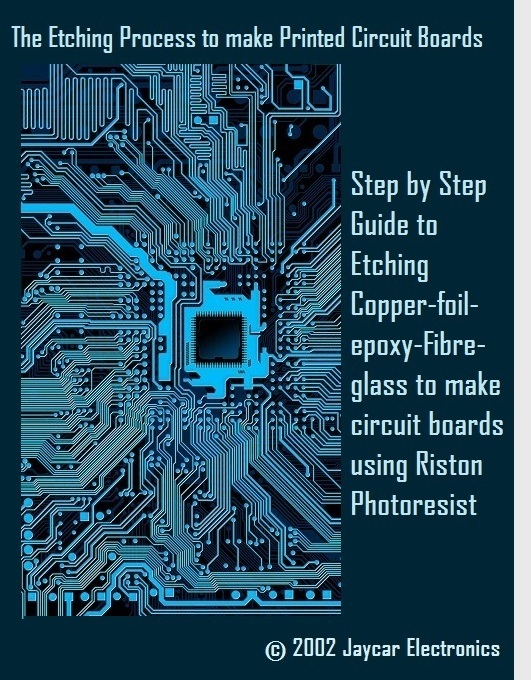
<.> <.> <.> <.> <.> <.>
_______________________________________________________________________________________________________
_______________________________________________________________________________________________________
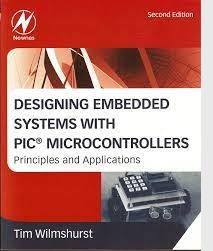 Designing Embedded Systems With PICMicrocontrollers - 2nd Edition by Tim Wilmhurst
This textbook teaches programming of Microcontrollers using Microchips PIC 16F84A and PIC F673A series Microcontrollers.
This textbook has a number of features that make it an excellent textbook, such as the block diagrams that show the inner workings of microcontrollers.
The textbook begins by explaining the basics of program memory and stack; Special Function Registers (SFR's); RAM Addressing; EEPROM Memory and
then onto the main idea behind Interrupts, Counters and Timers. The instruction set for Microchips microcontrollers is explained and the programming
is taught using assembly language which is closest to the inner workings of microcontrollers. Several practical programming codes in assembly language
are shown. The Pin connection diagrams for Microchips PIC 16F84A and PIC F673A series are shown and also the CPU structure using block diagrams and
Memory-maps are shown. The diagrams are excellent and the textbook is very well written.
Designing Embedded Systems With PICMicrocontrollers - 2nd Edition by Tim Wilmhurst
This textbook teaches programming of Microcontrollers using Microchips PIC 16F84A and PIC F673A series Microcontrollers.
This textbook has a number of features that make it an excellent textbook, such as the block diagrams that show the inner workings of microcontrollers.
The textbook begins by explaining the basics of program memory and stack; Special Function Registers (SFR's); RAM Addressing; EEPROM Memory and
then onto the main idea behind Interrupts, Counters and Timers. The instruction set for Microchips microcontrollers is explained and the programming
is taught using assembly language which is closest to the inner workings of microcontrollers. Several practical programming codes in assembly language
are shown. The Pin connection diagrams for Microchips PIC 16F84A and PIC F673A series are shown and also the CPU structure using block diagrams and
Memory-maps are shown. The diagrams are excellent and the textbook is very well written.
_______________________________________________________________________________________________________
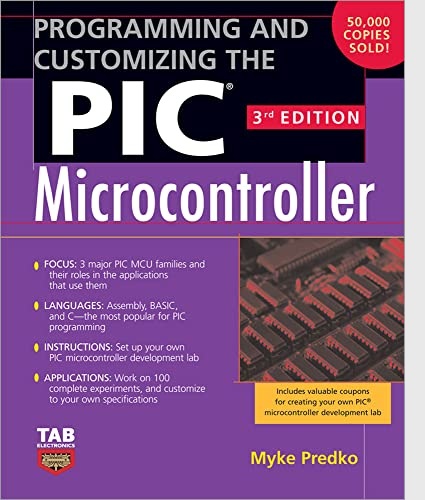 Programming and Customizing the PIC Microcontroller - 3rd Edition by Myke Predko
This is one of the best known books for learning programming of the PIC Microcontroller. This book provides a comprehensive and easy-to-understand
coverage of the PIC microcontroller hardware and software schemes. Software development focuses on Microchips MPLAB IDE software developement tool.
The book uses 3 families of PIC microcontrollers and shows examples of code written in assembly language and "C". The book features many experimental projects
showing the programming code for each project. Tables of instruction sets, Device-Pinouts, I/O-register-addresses for the PIC families are given.
This book has been written for readers with knowledge of programming and electronics .......it has many fatures that make it an excellent reference book.
Programming and Customizing the PIC Microcontroller - 3rd Edition by Myke Predko
This is one of the best known books for learning programming of the PIC Microcontroller. This book provides a comprehensive and easy-to-understand
coverage of the PIC microcontroller hardware and software schemes. Software development focuses on Microchips MPLAB IDE software developement tool.
The book uses 3 families of PIC microcontrollers and shows examples of code written in assembly language and "C". The book features many experimental projects
showing the programming code for each project. Tables of instruction sets, Device-Pinouts, I/O-register-addresses for the PIC families are given.
This book has been written for readers with knowledge of programming and electronics .......it has many fatures that make it an excellent reference book.
_______________________________________________________________________________________________________
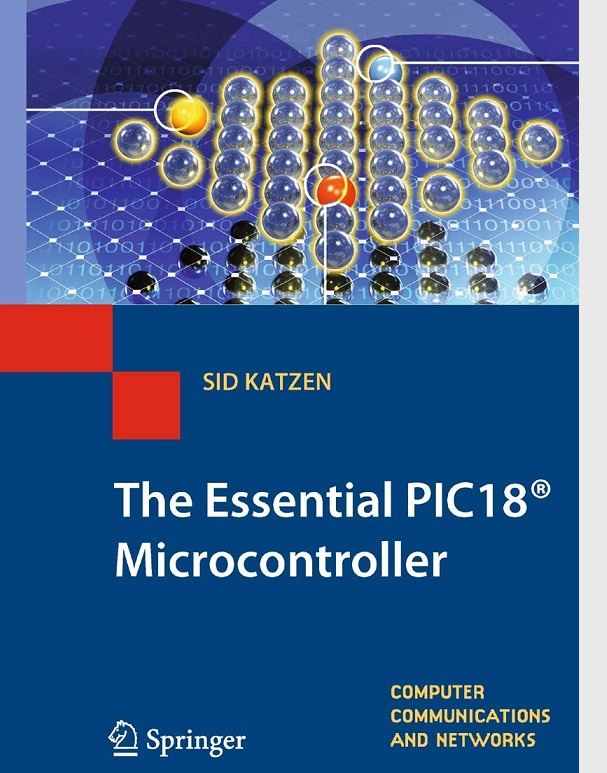 The Essential PIC18 Microcontroller by Sid Katzen
This book that teaches Microchips PIC18 family of Microcontrollers provides an in-depth understanding of these Microcontrollers....beginning
with a review of logic circuitry used in Microcontroller Architecture, the textbook then goes onto describe the Central Processing Unit; program memory and the differenet types of memory;
the Interface Ports; the Data Highway; Interrupts; a detailed description of the Stack and the instruction-set and onwards discusses the hardware aspects of interfacing and
interrupt handling and much more. The author also gives some history of PIC's since the inception in 1988 of Arizona Microchip Technology. There are many worked programming
excercises throughout the textbook and most of the chapters end with a set of programming excercises. There are NO solutions given in the textbook ..........however, a
tutorial and solutions manual is provided below
The Essential PIC18 Microcontroller by Sid Katzen
This book that teaches Microchips PIC18 family of Microcontrollers provides an in-depth understanding of these Microcontrollers....beginning
with a review of logic circuitry used in Microcontroller Architecture, the textbook then goes onto describe the Central Processing Unit; program memory and the differenet types of memory;
the Interface Ports; the Data Highway; Interrupts; a detailed description of the Stack and the instruction-set and onwards discusses the hardware aspects of interfacing and
interrupt handling and much more. The author also gives some history of PIC's since the inception in 1988 of Arizona Microchip Technology. There are many worked programming
excercises throughout the textbook and most of the chapters end with a set of programming excercises. There are NO solutions given in the textbook ..........however, a
tutorial and solutions manual is provided below
_______________________________________________________________________________________________________
_______________________________________________________________________________________________________
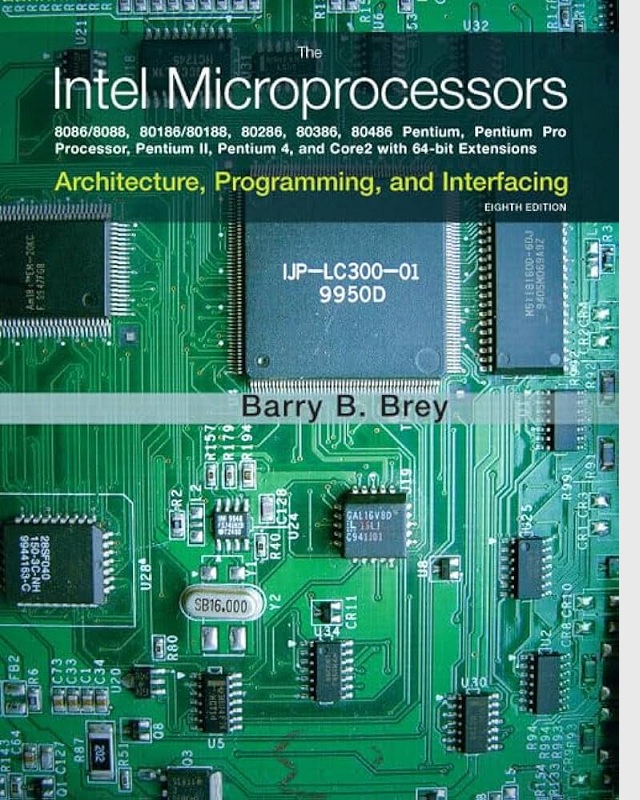 The Intel Microprocessors: Architecture, Programming and Interfacing - 8th Edition by Bary Brey
The INTEL Microprocessors is an excellent textbook for students to begin learning the operation of the microprocessor; starting with Intel's 8086/8088,
80186/80188, 80286, 80386, 80486, Pentium, Pentium Pro Processor, Pentium II, Pentium III, Pentium 4, and Core2 with 64-bit Extensions. This 8th Edition
provides a comprehensive view of programming and interfacing of the Intel family of Microprocessors from the 8088 through the latest Pentium 4 and
Core2 microprocessors. The text is written for students who need to learn about the programming and interfacing of Intel microprocessors, which have
gained wide and exclusive applications in many areas of electronics, communications, and control systems especially in desktop computer systems.
A new feature of this 8th edition is an explanation of how to interface C/C++ using Visual C++ Express (a free download from Microsoft) with assembly
language for both the older DOS and the Windows environments. Many applications include Visual C++ as a basis for learning assembly language using the
inline assembler. Updated sections that detail new events in the fields of microprocessors and microprocessor interfacing have been added. Organized in an
orderly and manageable format, this text offers more than 200 programming examples using the Microsoft Macro Assembler program and provides a thorough
description of each of the Intel family members, memory systems, and various I/O systems. Each of the 19 chapters ends with a large set of questions and problems.
Answers to odd numbered questions and problems are at the end of the textbook.
The Intel Microprocessors: Architecture, Programming and Interfacing - 8th Edition by Bary Brey
The INTEL Microprocessors is an excellent textbook for students to begin learning the operation of the microprocessor; starting with Intel's 8086/8088,
80186/80188, 80286, 80386, 80486, Pentium, Pentium Pro Processor, Pentium II, Pentium III, Pentium 4, and Core2 with 64-bit Extensions. This 8th Edition
provides a comprehensive view of programming and interfacing of the Intel family of Microprocessors from the 8088 through the latest Pentium 4 and
Core2 microprocessors. The text is written for students who need to learn about the programming and interfacing of Intel microprocessors, which have
gained wide and exclusive applications in many areas of electronics, communications, and control systems especially in desktop computer systems.
A new feature of this 8th edition is an explanation of how to interface C/C++ using Visual C++ Express (a free download from Microsoft) with assembly
language for both the older DOS and the Windows environments. Many applications include Visual C++ as a basis for learning assembly language using the
inline assembler. Updated sections that detail new events in the fields of microprocessors and microprocessor interfacing have been added. Organized in an
orderly and manageable format, this text offers more than 200 programming examples using the Microsoft Macro Assembler program and provides a thorough
description of each of the Intel family members, memory systems, and various I/O systems. Each of the 19 chapters ends with a large set of questions and problems.
Answers to odd numbered questions and problems are at the end of the textbook.
_______________________________________________________________________________________________________
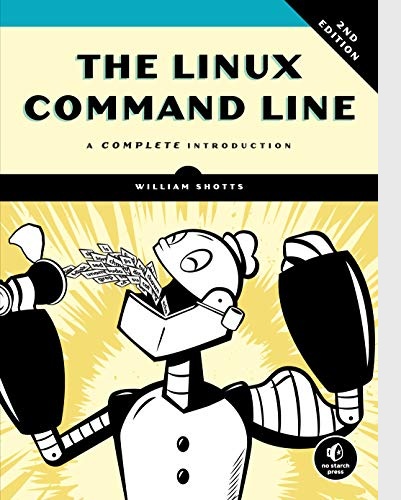 The Linux Command Line interface by William Shotts
This book teaches an overview of the Linux Command Line......it is targeted at the Linux Command Line User.
It's an excellent student textbook and reference for an IT Technician who needs to learn to administer a Linux Server. A unique
feature of this textbook is in getting the student acquanited with the Linux way of thinking; learning Linux is challenging and it
requires real effort. The book is divided into 4 parts; Part 1; Learning the Shell Part 2; Configuration
and the Environment Part 3; Common Tasks and Essential Tools Part 4; Writing Shell-Scripts.
The Linux Command Line interface by William Shotts
This book teaches an overview of the Linux Command Line......it is targeted at the Linux Command Line User.
It's an excellent student textbook and reference for an IT Technician who needs to learn to administer a Linux Server. A unique
feature of this textbook is in getting the student acquanited with the Linux way of thinking; learning Linux is challenging and it
requires real effort. The book is divided into 4 parts; Part 1; Learning the Shell Part 2; Configuration
and the Environment Part 3; Common Tasks and Essential Tools Part 4; Writing Shell-Scripts.
_______________________________________________________________________________________________________
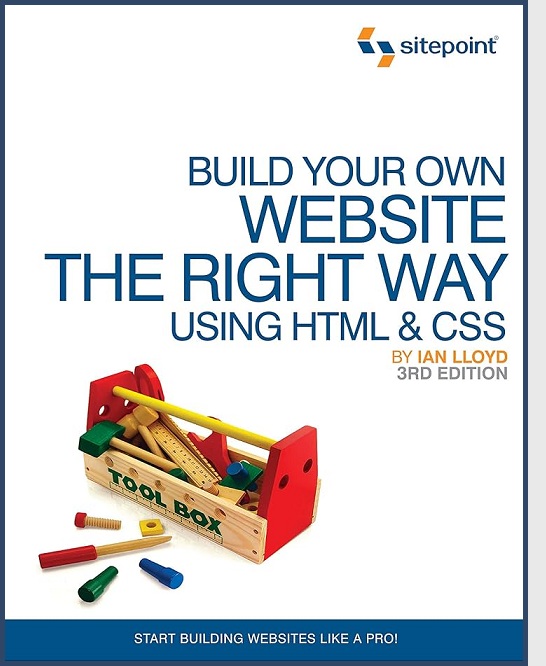 Build your own website the right way by Ian LLoyd
Using HTML & CSS, this is a practical guide and step-by-step companion to enable a student to build their first website....
and now in its third edition, this guide has been fully updated to include the latest operating systems, web browsers, and code fixes to the
most common problems. Using industry best practices, it shows the student how to build a professional-looking website that is easy to update
and functions in all browsers. Readers will learn how to style text and control page layout with CSS, create and optimize graphics for the Web,
add interactivity to websites with forms, include a custom search and user feedback pages, track visitors with Google Analytics, extend their
site's reach with social media, use HTML5 and CSS3 to add novel site features, and employ diagnosis and debug tools to find any problems
The graphics in the book are in colour. It is excellently written
Build your own website the right way by Ian LLoyd
Using HTML & CSS, this is a practical guide and step-by-step companion to enable a student to build their first website....
and now in its third edition, this guide has been fully updated to include the latest operating systems, web browsers, and code fixes to the
most common problems. Using industry best practices, it shows the student how to build a professional-looking website that is easy to update
and functions in all browsers. Readers will learn how to style text and control page layout with CSS, create and optimize graphics for the Web,
add interactivity to websites with forms, include a custom search and user feedback pages, track visitors with Google Analytics, extend their
site's reach with social media, use HTML5 and CSS3 to add novel site features, and employ diagnosis and debug tools to find any problems
The graphics in the book are in colour. It is excellently written
_______________________________________________________________________________________________________
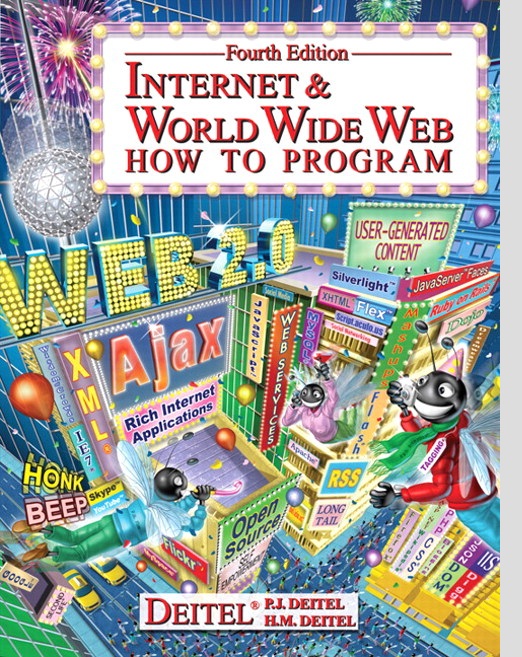 Internet and the World Wide Web - how to program - 4th Edition by P.J. Deitel and H.M. Deitel
For the student who has mastered the coursework given in the previous textbook (above) and who wants to start gaining expert knowledge
of front-end website programming; then this is a more comprehensive textbook that covers the fundamentals needed to program for the Internet, and provides in-depth coverage of
introductory programmming principles, various markup languages (XHTML, Dynamic HTML and XML), several scripting languages (JavaScript, PHP, Ruby/Ruby on Rails
and Perl); AJAX, web services, Web Servers (IIS and Apache) and relational databases (MySQL/Apache Derby/Java DB) -- all the skills and tools needed to
create dynamic Web-based applications. There are comprehensive introductions to ASP.NET 2.0 and JavaServer Faces (JSF) and a chapter on
Adobe Flex 2.0. There are hundreds of code examples of real applications throughout the textbook. there are also provides instructions on building
Ajax-enabled rich Internet applications that enhance the presentation of online content and give web applications the look and feel of desktop applications.
Each of the 28 chapters has end-of-chapter review-exercises with answers given. This textbook was first published in 1999 and this 4th edition was published in 2008
Internet and the World Wide Web - how to program - 4th Edition by P.J. Deitel and H.M. Deitel
For the student who has mastered the coursework given in the previous textbook (above) and who wants to start gaining expert knowledge
of front-end website programming; then this is a more comprehensive textbook that covers the fundamentals needed to program for the Internet, and provides in-depth coverage of
introductory programmming principles, various markup languages (XHTML, Dynamic HTML and XML), several scripting languages (JavaScript, PHP, Ruby/Ruby on Rails
and Perl); AJAX, web services, Web Servers (IIS and Apache) and relational databases (MySQL/Apache Derby/Java DB) -- all the skills and tools needed to
create dynamic Web-based applications. There are comprehensive introductions to ASP.NET 2.0 and JavaServer Faces (JSF) and a chapter on
Adobe Flex 2.0. There are hundreds of code examples of real applications throughout the textbook. there are also provides instructions on building
Ajax-enabled rich Internet applications that enhance the presentation of online content and give web applications the look and feel of desktop applications.
Each of the 28 chapters has end-of-chapter review-exercises with answers given. This textbook was first published in 1999 and this 4th edition was published in 2008
_______________________________________________________________________________________________________
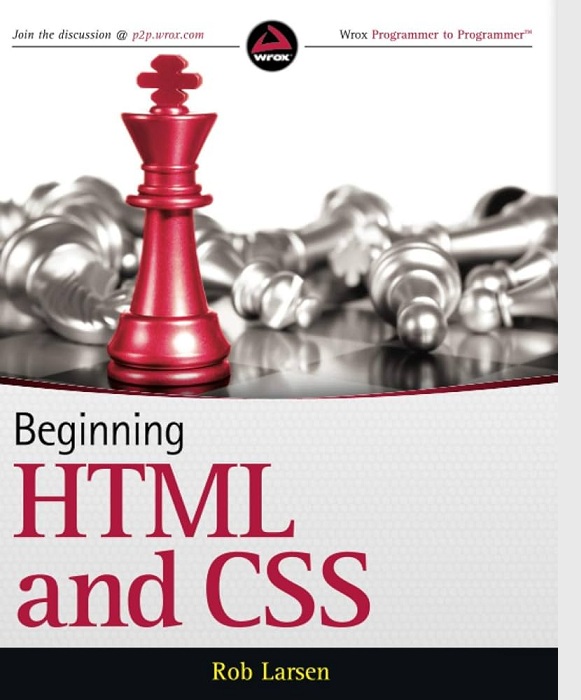 Beginning HTML and CSS by Rob Larson
This textbook provides step by step guidance on the best practices to coding with html and css to develop
websites that will be accessed by multiple devices and platforms. Each chapter ends with exercises; the answers
to the end-of-chpater exercises are at the end of the book. This is an excellent reference book that covers everything
from structuring documents for the web and linking to other webpages and e-mail addresses.......using audio and video, tables,
backgrounds and borders, text-shadowing and also includes a section on the jQuery library and more
Beginning HTML and CSS by Rob Larson
This textbook provides step by step guidance on the best practices to coding with html and css to develop
websites that will be accessed by multiple devices and platforms. Each chapter ends with exercises; the answers
to the end-of-chpater exercises are at the end of the book. This is an excellent reference book that covers everything
from structuring documents for the web and linking to other webpages and e-mail addresses.......using audio and video, tables,
backgrounds and borders, text-shadowing and also includes a section on the jQuery library and more
_______________________________________________________________________________________________________
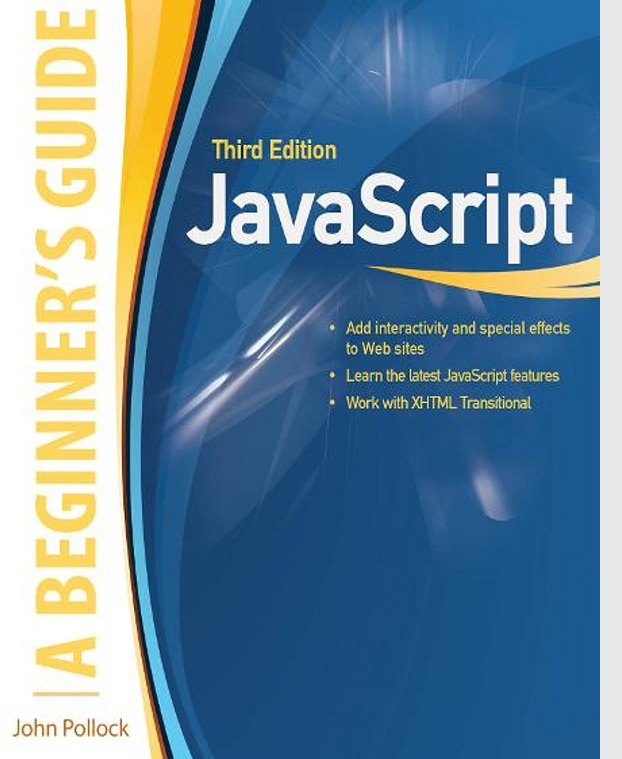 JavaScript: A Beginners Guide - 3rd Edition by John Pollock
This is a beginners textbook that teaches the fundamentals of the Javascript website development programming langauage.
The 16 Chapters have several novel features; ***Key Skills and Concepts; a section titled ***Ask the Expert:
that's filled with relevant information. Cautions: .....errors and pitfalls to avoid Self-tests: end of chapter
self-tests with answers at the end of the book..... aswell as many more features. The last chapter teaches on HTML5 and JQuery.
This is an exceptionally well written programming book
JavaScript: A Beginners Guide - 3rd Edition by John Pollock
This is a beginners textbook that teaches the fundamentals of the Javascript website development programming langauage.
The 16 Chapters have several novel features; ***Key Skills and Concepts; a section titled ***Ask the Expert:
that's filled with relevant information. Cautions: .....errors and pitfalls to avoid Self-tests: end of chapter
self-tests with answers at the end of the book..... aswell as many more features. The last chapter teaches on HTML5 and JQuery.
This is an exceptionally well written programming book
_______________________________________________________________________________________________________
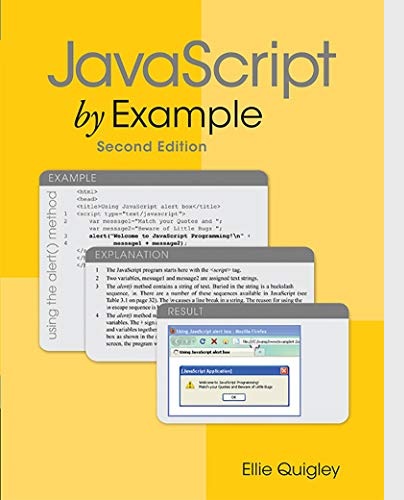 Javascript by Example - 2nd Edition by Ellie Quigly
This well written and classic textbook teaches javascript and also has a chapter that provides an introduction to
AJAX and JSON. The textbook has a host of examples in each chapter and each chapter ends with a set of exercises that use the
concepts taught in the chapter to create interactive webpages. The textbook includes; working with forms; input devices;
working with images (and links); Browser Objects; introduces CSS with Javascript; Cookies; pattern-matching and more.
The author had been teaching scripting languages in Silicon Valley (California ) for more than 20 years; since the early days of
website programing.
Javascript by Example - 2nd Edition by Ellie Quigly
This well written and classic textbook teaches javascript and also has a chapter that provides an introduction to
AJAX and JSON. The textbook has a host of examples in each chapter and each chapter ends with a set of exercises that use the
concepts taught in the chapter to create interactive webpages. The textbook includes; working with forms; input devices;
working with images (and links); Browser Objects; introduces CSS with Javascript; Cookies; pattern-matching and more.
The author had been teaching scripting languages in Silicon Valley (California ) for more than 20 years; since the early days of
website programing.
_______________________________________________________________________________________________________
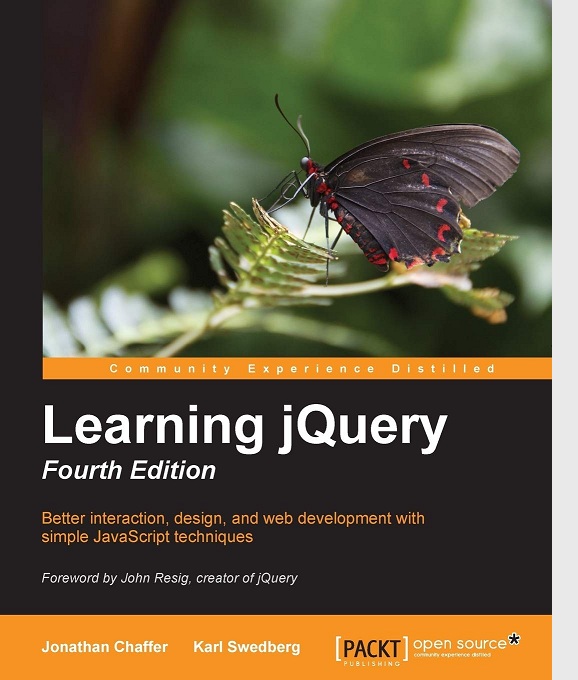 Learning JQuery - 4th Edition by Jonathan Chaffer and Karl Swedberg
Learning jQuery Fourth Edition is revised and updated version of jQuery. The student will learn the basics of jQuery
for adding interactions and animations to their webpages. Even if previous attempts at writing JavaScript have left the student baffled,
this book will guide them past the pitfalls associated with AJAX, events, effects, and advanced JavaScript language features. Starting
with an introduction to jQuery, the student will first be shown how to write a functioning jQuery program in just three lines of code.
They will Learn how to add impact to their webpages through a set of simple visual effects and to create, copy and reassemble,
content using jQuery's DOM modification methods. The book will take the student through many detailed, real-world examples, and even
equip them to extend the jQuery library itself with their own plug-ins.
Learning JQuery - 4th Edition by Jonathan Chaffer and Karl Swedberg
Learning jQuery Fourth Edition is revised and updated version of jQuery. The student will learn the basics of jQuery
for adding interactions and animations to their webpages. Even if previous attempts at writing JavaScript have left the student baffled,
this book will guide them past the pitfalls associated with AJAX, events, effects, and advanced JavaScript language features. Starting
with an introduction to jQuery, the student will first be shown how to write a functioning jQuery program in just three lines of code.
They will Learn how to add impact to their webpages through a set of simple visual effects and to create, copy and reassemble,
content using jQuery's DOM modification methods. The book will take the student through many detailed, real-world examples, and even
equip them to extend the jQuery library itself with their own plug-ins.
_______________________________________________________________________________________________________
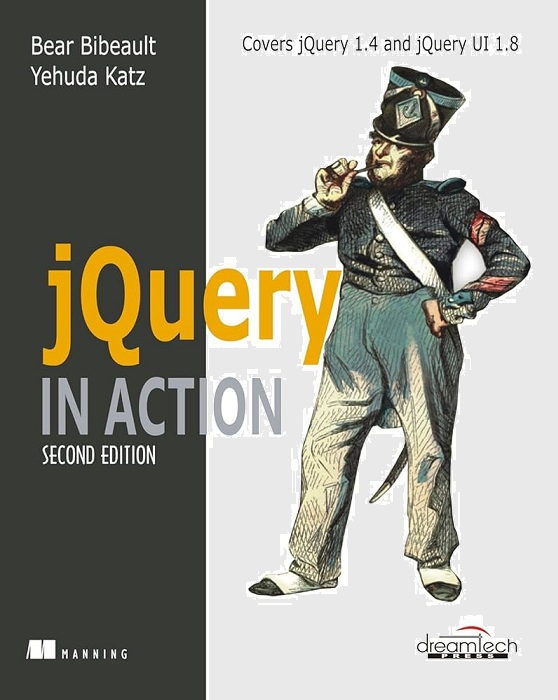 JQuery in Action - 2nd Edition by Bear Bibeault and Yehuda Katz
jQuery in Action, Second Edition is a fast-paced introduction and guide. It shows the student how to traverse HTML documents,
handle events, perform animations, and add Ajax to their web pages. The book's unique "lab pages" anchor the explanation of each new concept
in a practical example. They will learn how jQuery interacts with other tools and frameworks and how to build jQuery plugins. This revised
and expanded second edition includes even more lab pages than before, along with numerous examples that show the latest best practices developed by the
jQuery community. It provides full coverage of jQuery 1.4, along with a deeper look at the ever-expanding world of jQuery plug-ins.
This book requires some knowledge of JavaScript and Ajax but no previous experience with jQuery.
JQuery in Action - 2nd Edition by Bear Bibeault and Yehuda Katz
jQuery in Action, Second Edition is a fast-paced introduction and guide. It shows the student how to traverse HTML documents,
handle events, perform animations, and add Ajax to their web pages. The book's unique "lab pages" anchor the explanation of each new concept
in a practical example. They will learn how jQuery interacts with other tools and frameworks and how to build jQuery plugins. This revised
and expanded second edition includes even more lab pages than before, along with numerous examples that show the latest best practices developed by the
jQuery community. It provides full coverage of jQuery 1.4, along with a deeper look at the ever-expanding world of jQuery plug-ins.
This book requires some knowledge of JavaScript and Ajax but no previous experience with jQuery.
_______________________________________________________________________________________________________
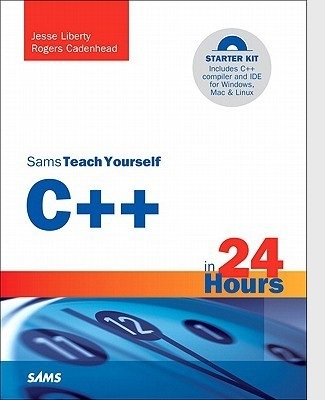 Teach yourself C++ in 24 hours by Jesse Liberty and Rogers Cadenhead
This widely used textbook teaches the basics of C++.....a popular and powerful programming language.........
in 24 lessons. Each lesson builds on the previous lesson; Step by step instructions teach the most common C++
programming tasks. Each chapter ends with Quizzes and exercises so the reader can be sure they are ready to move onto
the the next lesson. The answers are given Each chapter includes notes and tips that point out shortcuts and solutions
Teach yourself C++ in 24 hours by Jesse Liberty and Rogers Cadenhead
This widely used textbook teaches the basics of C++.....a popular and powerful programming language.........
in 24 lessons. Each lesson builds on the previous lesson; Step by step instructions teach the most common C++
programming tasks. Each chapter ends with Quizzes and exercises so the reader can be sure they are ready to move onto
the the next lesson. The answers are given Each chapter includes notes and tips that point out shortcuts and solutions
_______________________________________________________________________________________________________
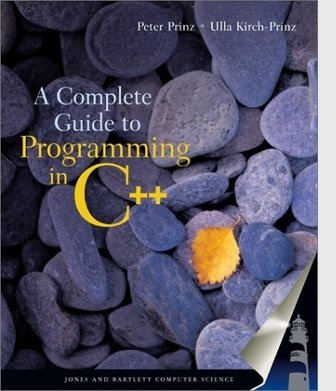 A Complete Guide to Programming in C++ by Ulla Kirch-Prinz and Peter Prinz
This book was written for readers interested in learning the C++ programming language from scratch, and for both novice
and advanced C++ programmers wishing to enhance their knowledge of C++. It was our goal from the beginning to design this text with the
capabilities of serving dual markets, as a textbook and as a holistic reference manual for professionals.
The chapters in this book are organized to guide the reader from elementary language concepts to professional software development, with
in-depth coverage of all the C++ language elements en route. The order in which these elements are discussed reflects our goal of helping
the reader to create useful every step of the way. (taken form the preface of the textbook )
A Complete Guide to Programming in C++ by Ulla Kirch-Prinz and Peter Prinz
This book was written for readers interested in learning the C++ programming language from scratch, and for both novice
and advanced C++ programmers wishing to enhance their knowledge of C++. It was our goal from the beginning to design this text with the
capabilities of serving dual markets, as a textbook and as a holistic reference manual for professionals.
The chapters in this book are organized to guide the reader from elementary language concepts to professional software development, with
in-depth coverage of all the C++ language elements en route. The order in which these elements are discussed reflects our goal of helping
the reader to create useful every step of the way. (taken form the preface of the textbook )
_______________________________________________________________________________________________________
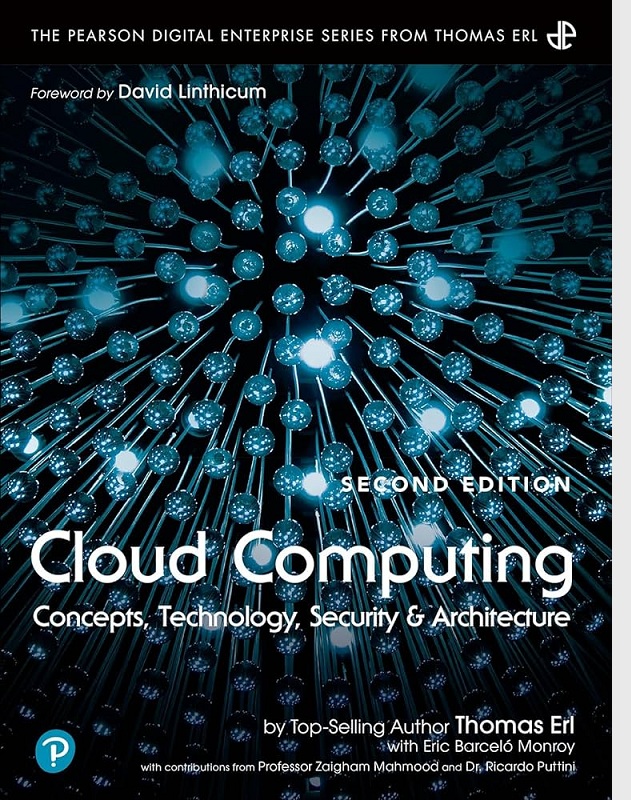 Cloud Computing: Concepts Technology Security and Architecture - 2nd Edition by Thomas Erl and Eric Barcelo Monroy
In Cloud Computing: Concepts, Technology, Security & Architecture, one of the world's top-selling IT authors, Thomas Erl teams up with cloud computing
expert Eric Barceló Monroy and researchers to break down proven and mature cloud computing technologies and practices into a series of well-defined concepts,
technology mechanisms, and technology architectures. Comprehensive coverage of containerisation and cybersecurity topics is also included.
All chapters are carefully authored from an industry-centered and vendor-neutral point of view. In doing so, the book establishes concrete, academic coverage
with a focus on structure, clarity, and well-defined building blocks and solutions for mainstream cloud computing platforms.
With 370 figures, 40 architectural models, and 50 mechanisms, this indispensable guide provides a comprehensive education of
contemporary cloud computing and cybersecurity. This textbook was first published in 2013 and this 2nd edition was puiblished in 2023
Cloud Computing: Concepts Technology Security and Architecture - 2nd Edition by Thomas Erl and Eric Barcelo Monroy
In Cloud Computing: Concepts, Technology, Security & Architecture, one of the world's top-selling IT authors, Thomas Erl teams up with cloud computing
expert Eric Barceló Monroy and researchers to break down proven and mature cloud computing technologies and practices into a series of well-defined concepts,
technology mechanisms, and technology architectures. Comprehensive coverage of containerisation and cybersecurity topics is also included.
All chapters are carefully authored from an industry-centered and vendor-neutral point of view. In doing so, the book establishes concrete, academic coverage
with a focus on structure, clarity, and well-defined building blocks and solutions for mainstream cloud computing platforms.
With 370 figures, 40 architectural models, and 50 mechanisms, this indispensable guide provides a comprehensive education of
contemporary cloud computing and cybersecurity. This textbook was first published in 2013 and this 2nd edition was puiblished in 2023
_______________________________________________________________________________________________________
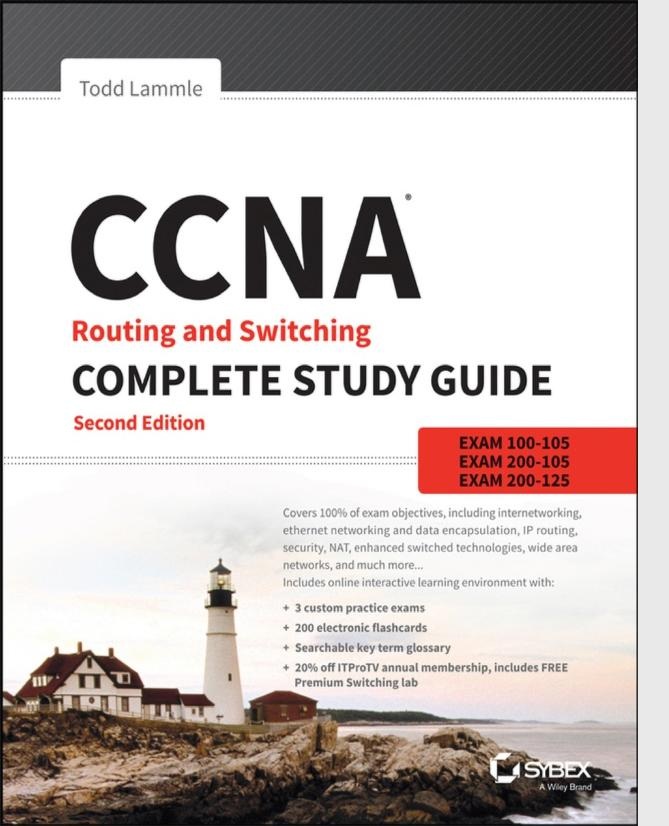 CCNA Routing and Switching - 2nd Edition by Todd Lammie
This widely used textbook; CCNA Routing and Switching has been written by a Cisco expert
and an authority on Cisco certification with decades of experience in implementing and troubleshooting large scale Cisco
data centres. The textbook begins by teaching the basics of Ethernet Networking; Data Encapsulation and TCP/IP and
then moves onto teach the basics of Cisco's Internet-working operating system, and then IP routing. Each chapter
ends with a set of 20 review questions; the answers are given at the end of the textbook. The clarity and the
insight which this textbook provides make it outstanding
CCNA Routing and Switching - 2nd Edition by Todd Lammie
This widely used textbook; CCNA Routing and Switching has been written by a Cisco expert
and an authority on Cisco certification with decades of experience in implementing and troubleshooting large scale Cisco
data centres. The textbook begins by teaching the basics of Ethernet Networking; Data Encapsulation and TCP/IP and
then moves onto teach the basics of Cisco's Internet-working operating system, and then IP routing. Each chapter
ends with a set of 20 review questions; the answers are given at the end of the textbook. The clarity and the
insight which this textbook provides make it outstanding
_______________________________________________________________________________________________________
_______________________________________________________________________________________________________
The remaining textbooks shown below would be used for advanced undergraduate courses in Science and Engineering
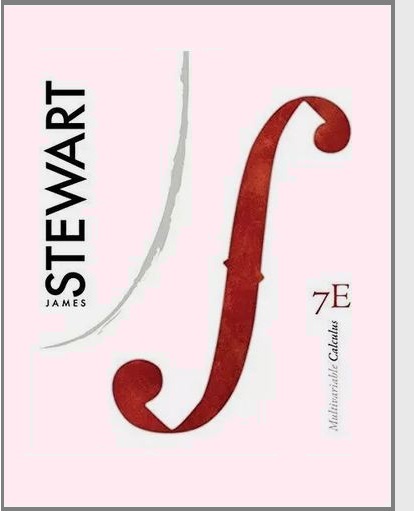 Multivariable Calculus - 7th Edition by James Stewart
This authors CALCULUS textbooks are world-wide best-sellers. His textbooks are clear, accurate, and
filled with relevant, real-world practical examples. In MULTIVARIABLE CALCULUS, Seventh Edition, the author
teaches advanced calculus topics; Parametric Equations and Polar Derivatives:
Infinite Sequences and Series: Vector Functions: Partial Derivaties: Multiple Integrals and more.
Each chapter ends with a large selection of end-of-chapter problems. Answers to the end-of-chapter problems are at the
end of the book
Multivariable Calculus - 7th Edition by James Stewart
This authors CALCULUS textbooks are world-wide best-sellers. His textbooks are clear, accurate, and
filled with relevant, real-world practical examples. In MULTIVARIABLE CALCULUS, Seventh Edition, the author
teaches advanced calculus topics; Parametric Equations and Polar Derivatives:
Infinite Sequences and Series: Vector Functions: Partial Derivaties: Multiple Integrals and more.
Each chapter ends with a large selection of end-of-chapter problems. Answers to the end-of-chapter problems are at the
end of the book
_______________________________________________________________________________________________________
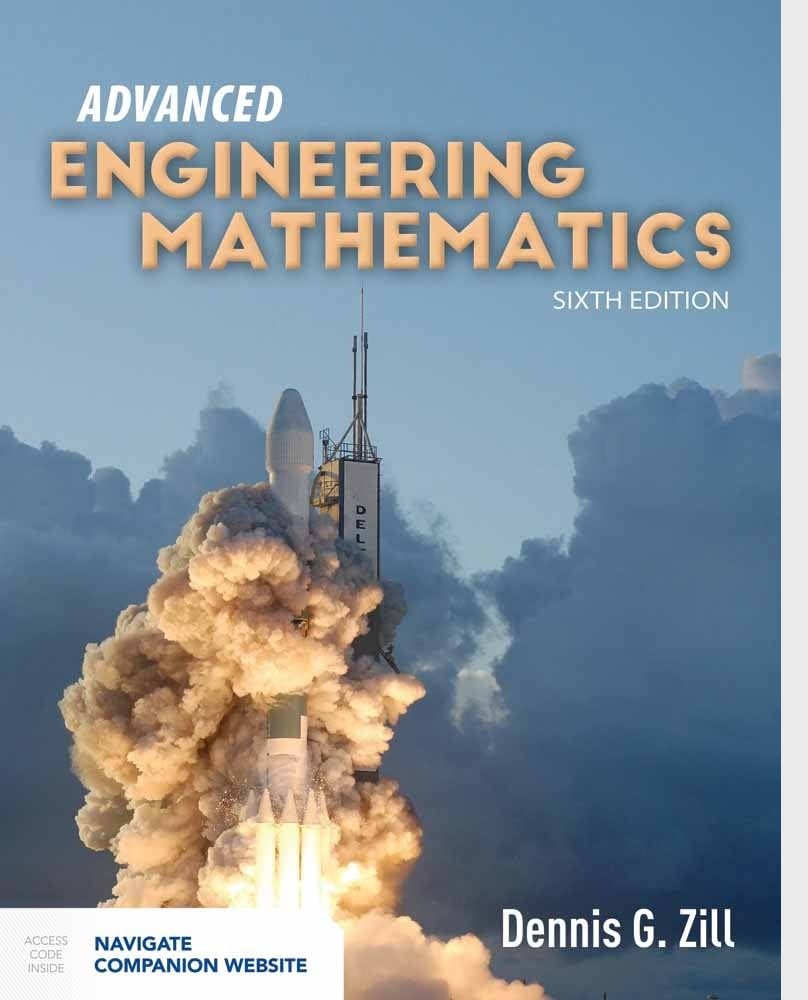 Advanced Enginering Mathematics - 6th Edition by Dennis Zill
This textbook teaches Advanced Mathematics to Scientists and Engineers. First published in 1992 this textbook
is now in it's 6th Edition. In almost every chapter the author shows many examples of solving problems in engineering using
advanced mathematical methods and using mathematical modelling. Every chapter has a number of exercises for each section and the
end-of-chapter exercises are challenging and interesting. The answers to odd numbered exercises are at the end of the book.
This 6th edition is in colour. The authors derivations and modelling are easy to follow
Advanced Enginering Mathematics - 6th Edition by Dennis Zill
This textbook teaches Advanced Mathematics to Scientists and Engineers. First published in 1992 this textbook
is now in it's 6th Edition. In almost every chapter the author shows many examples of solving problems in engineering using
advanced mathematical methods and using mathematical modelling. Every chapter has a number of exercises for each section and the
end-of-chapter exercises are challenging and interesting. The answers to odd numbered exercises are at the end of the book.
This 6th edition is in colour. The authors derivations and modelling are easy to follow
_______________________________________________________________________________________________________
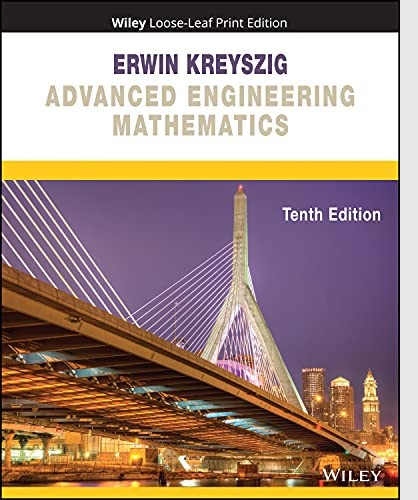 Advanced Enginering Mathematics - 10th Edition by Erwin Kreyszig
This is another widely used textbook that teaches Advanced Mathematics to Scientists and Engineers, however this textbook is
much more difficult to work through than the previous textbook shown above. The emphasis in this textbook is in modelling of physical scenarios
into a mathematical model, and solving practical problems taken from scenarios in physics, chemistry and engineering. The author provides
excellent insights into abstract mathematical concepts. Each section ends with a set of exercises and each chapter ends with a set of review
questions and problems. The answers to odd-numbered problems are given at the end of the book. The late Erwin Otto Keyszig was a German-Canadian
mathematician who specialised in applied mathematics. He was the author of many mathematics books but this is his best known book. This 10th
edition was published in 2011
Advanced Enginering Mathematics - 10th Edition by Erwin Kreyszig
This is another widely used textbook that teaches Advanced Mathematics to Scientists and Engineers, however this textbook is
much more difficult to work through than the previous textbook shown above. The emphasis in this textbook is in modelling of physical scenarios
into a mathematical model, and solving practical problems taken from scenarios in physics, chemistry and engineering. The author provides
excellent insights into abstract mathematical concepts. Each section ends with a set of exercises and each chapter ends with a set of review
questions and problems. The answers to odd-numbered problems are given at the end of the book. The late Erwin Otto Keyszig was a German-Canadian
mathematician who specialised in applied mathematics. He was the author of many mathematics books but this is his best known book. This 10th
edition was published in 2011
_______________________________________________________________________________________________________
Differential Equations with Boundary Value Problems - 7th Edition by
Dennis Zill and Michael Cullen Diferential Equations are covered in Advanced Engineering Mathematics
by Dennis Zill, however this widely used textbook provides a comprehensive study of these equations and also the modeling
of real world engineering scenarios showing how to formulate the problem so it can be solved using one of many types of
differential equations. Each chapter has several worked problems and each chapter has a large set of end-of-chapter
problems......answers to most of these problems are at the end of the textbook. This is a well written mathematics
textbook. This e-book edition is in colour; The typset is excellent
_______________________________________________________________________________________________________
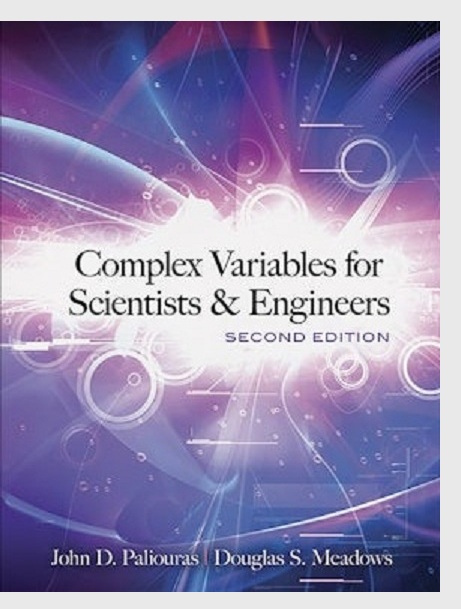 Complex Variables for Scientists and Engineers - 2nd Edition by John D. Paliouras
Complex Variables are covered in Advanced Engineering Mathematics by Dennis Zill, however this textbook opens up the door to
the real world of Complex Variables starting with a discussion of Complex Numbers in which the author provides an elegant derivation that
is the basis of this powerful mathematical tool. Throughout the textbook the author provides derivations to all the formula he uses
and each chapter contains theorems together with the proofs and also several worked exercises. Each chapter ends with a set of
end-of-chapter exercises and answers to most of the exercises are given at the end of the book
Complex Variables for Scientists and Engineers - 2nd Edition by John D. Paliouras
Complex Variables are covered in Advanced Engineering Mathematics by Dennis Zill, however this textbook opens up the door to
the real world of Complex Variables starting with a discussion of Complex Numbers in which the author provides an elegant derivation that
is the basis of this powerful mathematical tool. Throughout the textbook the author provides derivations to all the formula he uses
and each chapter contains theorems together with the proofs and also several worked exercises. Each chapter ends with a set of
end-of-chapter exercises and answers to most of the exercises are given at the end of the book
_______________________________________________________________________________________________________
_______________________________________________________________________________________________________
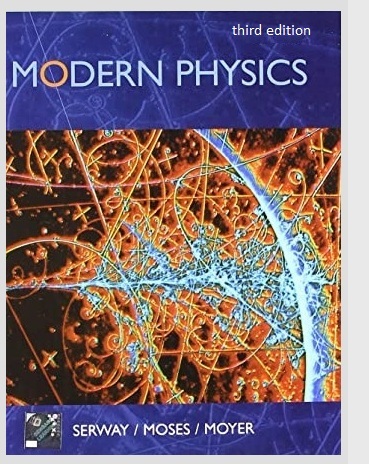 Modern Physics - 3rd Edition by by Serway, Moses and Moyer
This is a Modern Physics textbook for students who are majoring in one of the Physicial Sciences or
Engineering. This is a very well writen textbook that would have as much value as masterpiece in English prose
as it would have as a Physics textbook. The 1st edition was published in 1989 and this 3rd edition published in 2005
has a number of innovations. The diagrams and pictures throughout this textbook are excellent and the end-of-chapter
question and problems require a good understanding of the concepts to solve them. The answers to odd numbered problems
are given at the end of the book. This textbook assumes that the student is proficient in Calculus.
Modern Physics - 3rd Edition by by Serway, Moses and Moyer
This is a Modern Physics textbook for students who are majoring in one of the Physicial Sciences or
Engineering. This is a very well writen textbook that would have as much value as masterpiece in English prose
as it would have as a Physics textbook. The 1st edition was published in 1989 and this 3rd edition published in 2005
has a number of innovations. The diagrams and pictures throughout this textbook are excellent and the end-of-chapter
question and problems require a good understanding of the concepts to solve them. The answers to odd numbered problems
are given at the end of the book. This textbook assumes that the student is proficient in Calculus.
_______________________________________________________________________________________________________
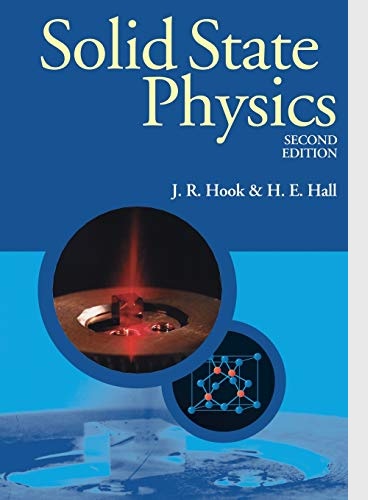 Solid State Physics - 2nd Edition by J. Hook and H. Hall
This Physics textbook teaches the thermal, electrical, magnetic, and optical properties of solids and
the unqique properties of crystals. It's more of a topic in Chemistry than Physics because the ionic, covalent and
metallic bonding of solids is explored. Crystalline solids; Solids with an atomic structure that have a regular pattern
are also explored. The textbook begins by illustrating the methods to describe the structure of crystals, then moves
onto describe Free-electrons in metals; Semiconductor devices; Magnetism in solids; Electric properties of insulators;
Superconductivity and more. Each chapter has a set of end-of-chapter problems and answers to ALL
end-of-chapter problems are given at the end of the textbook. the typset used is clear; All the concepts are aided by
the diagrams/pictures which provide visual insight. With all it's features this textbook is an excellent
student resource
Solid State Physics - 2nd Edition by J. Hook and H. Hall
This Physics textbook teaches the thermal, electrical, magnetic, and optical properties of solids and
the unqique properties of crystals. It's more of a topic in Chemistry than Physics because the ionic, covalent and
metallic bonding of solids is explored. Crystalline solids; Solids with an atomic structure that have a regular pattern
are also explored. The textbook begins by illustrating the methods to describe the structure of crystals, then moves
onto describe Free-electrons in metals; Semiconductor devices; Magnetism in solids; Electric properties of insulators;
Superconductivity and more. Each chapter has a set of end-of-chapter problems and answers to ALL
end-of-chapter problems are given at the end of the textbook. the typset used is clear; All the concepts are aided by
the diagrams/pictures which provide visual insight. With all it's features this textbook is an excellent
student resource
_______________________________________________________________________________________________________
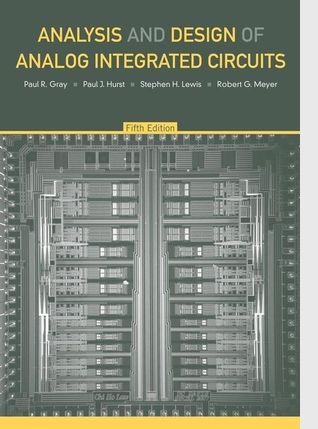 Analysis and Design of Analogue Integrated Circuits - 5th Edition by by Paul Gray, Paul Hurst, Stephen Lewis, Robert Meyer
This textbook grew out of courses on analogue electronic circuits taught at the University of California ....the textbook
teaches the physics of electronic devices with the emphasis being on device construction in the fabrication of integrated circuits.
The textbook begins with a summary of the physics of bipolar and MOS transistors and a description of integrated circuit fabrication:
Photolithography and Epitaxial Growth. Onwards the textbook describes fabrication of resistors, diodes, n-channel and p-channel transistors,
MOS transistors and more. Onwards is a detailed description of current mirrors; feedback; amplifier frequency response; op-amps;
phase-locked-loops; and more. This textbook has been co-authoured by Engineers whom have had practical experience designing integrated circuits.
Each chapter has exercises with worked solutions that apply the theory. There are several features in the textbook that make it an
excellent student resource and reference book.
Analysis and Design of Analogue Integrated Circuits - 5th Edition by by Paul Gray, Paul Hurst, Stephen Lewis, Robert Meyer
This textbook grew out of courses on analogue electronic circuits taught at the University of California ....the textbook
teaches the physics of electronic devices with the emphasis being on device construction in the fabrication of integrated circuits.
The textbook begins with a summary of the physics of bipolar and MOS transistors and a description of integrated circuit fabrication:
Photolithography and Epitaxial Growth. Onwards the textbook describes fabrication of resistors, diodes, n-channel and p-channel transistors,
MOS transistors and more. Onwards is a detailed description of current mirrors; feedback; amplifier frequency response; op-amps;
phase-locked-loops; and more. This textbook has been co-authoured by Engineers whom have had practical experience designing integrated circuits.
Each chapter has exercises with worked solutions that apply the theory. There are several features in the textbook that make it an
excellent student resource and reference book.
_______________________________________________________________________________________________________
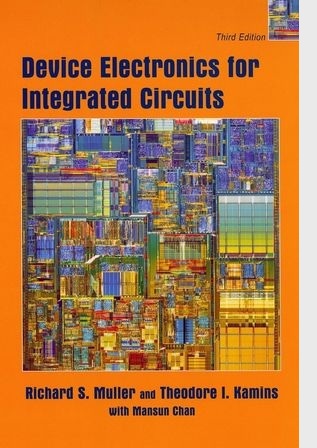 Device Electronics for Inegrated Circuits - 3rd Edition by by Robert Muller and Theodore Kamins
This textbook that focuses specifically on silicon devices is ideally for students whom have completed courses in electronic-devices and integrated-circuits.
This textbook teaches the fundamental physics through to detailed device operation. Because the book focuses primarily on silicon devices, each topic can
include more depth, and extensive worked examples and practice problems. This textbook grew out of a course in device electronics taught by experts in the field
of integrated circuit design at the University of California at Berkeley. Each chapter has a large number of end-of-chapter practice problems. There are
only a few answers given to these end-of-chapter problems at the end of the book However a Solutions Manual for this textboook is provided below.
This third Edition of Device Electronics for Integrated Circuits was published in 2002
Device Electronics for Inegrated Circuits - 3rd Edition by by Robert Muller and Theodore Kamins
This textbook that focuses specifically on silicon devices is ideally for students whom have completed courses in electronic-devices and integrated-circuits.
This textbook teaches the fundamental physics through to detailed device operation. Because the book focuses primarily on silicon devices, each topic can
include more depth, and extensive worked examples and practice problems. This textbook grew out of a course in device electronics taught by experts in the field
of integrated circuit design at the University of California at Berkeley. Each chapter has a large number of end-of-chapter practice problems. There are
only a few answers given to these end-of-chapter problems at the end of the book However a Solutions Manual for this textboook is provided below.
This third Edition of Device Electronics for Integrated Circuits was published in 2002
_______________________________________________________________________________________________________
_______________________________________________________________________________________________________
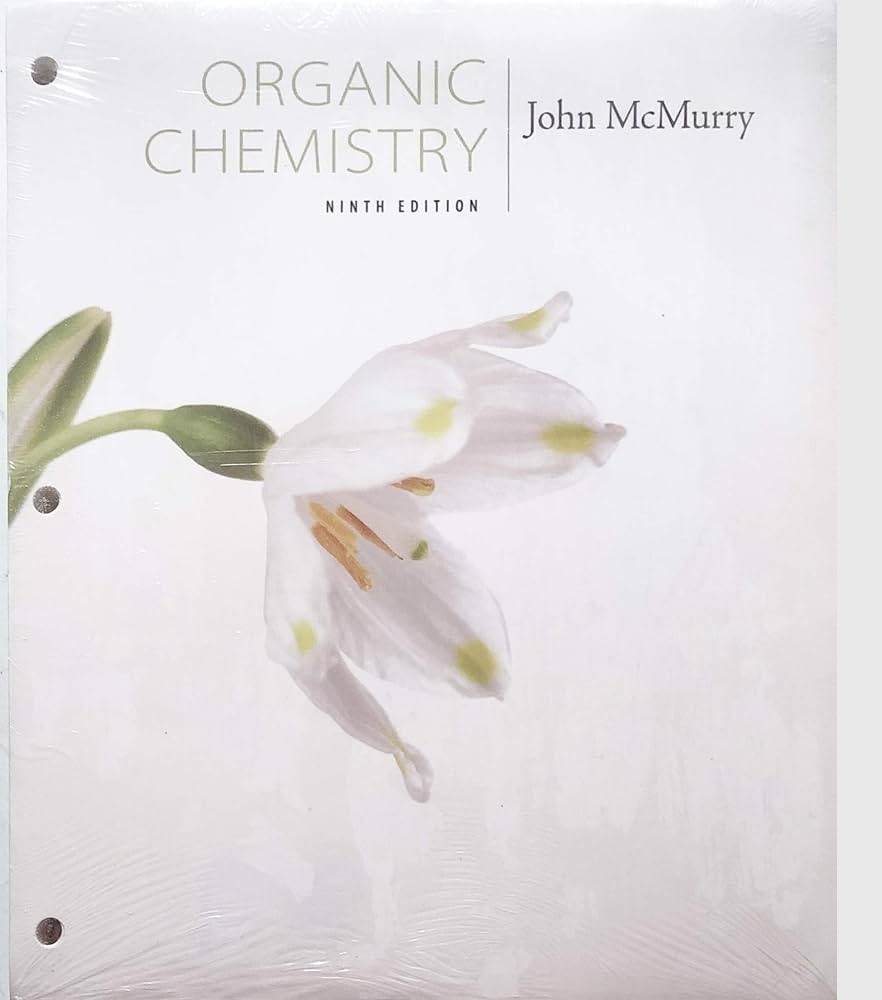 Organic Chemistry - 9th Edition by by John McMurry
This is a widely used textbook that's in it's ninth edition. This edition as well as most previous edition
has coloured pictures and many innovative features including specialized topics related to organic chemistry. Each chapter
ends with an essay on a specialized topic and also with a large number of end-of-chapter problems. The answers to most
of the end-of-chapter problems are given at the end of the textbook
Organic Chemistry - 9th Edition by by John McMurry
This is a widely used textbook that's in it's ninth edition. This edition as well as most previous edition
has coloured pictures and many innovative features including specialized topics related to organic chemistry. Each chapter
ends with an essay on a specialized topic and also with a large number of end-of-chapter problems. The answers to most
of the end-of-chapter problems are given at the end of the textbook
_______________________________________________________________________________________________________
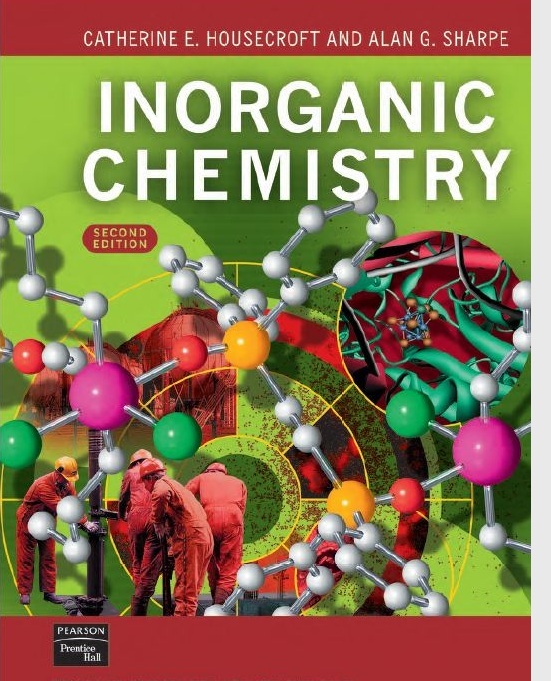 Inorganic Chemistry - 2nd Edition by Catherine Housecroft and Alan Sharpe
This is another widely used textbook that provides a comprehensive and clear introduction to key principles of Inorganic Chemistry
with strong coverage of descriptive chemistry of the elements. Specially selected topics are included, covering inorganic kinetics and
mechanism, catalysis, solid state chemistry and bioinorganic chemistry. The full-colour text design and three-dimensional illustrations bring
inorganic chemistry to life. Topic boxes have been used extensively throughout the book to relate the chemistry described in the text to everyday
life, the chemical industry, environmental issues and natural resources. Teaching aids throughout the text have been
designed to help students learn effectively. The many worked examples take students through each calculation or exercise step by step, and are
followed by self-study exercises tackling similar problems...... (with answers provided). In addition, there is a great number of end-of-chapter
problems that reinforce and develop subject knowledge and skills. Answers to all 'non-descriptive' problems are at the end of the Book.
Also at the end of each chapter is further reading suggestions for the student wanting to explore a topic in more depth.
Inorganic Chemistry - 2nd Edition by Catherine Housecroft and Alan Sharpe
This is another widely used textbook that provides a comprehensive and clear introduction to key principles of Inorganic Chemistry
with strong coverage of descriptive chemistry of the elements. Specially selected topics are included, covering inorganic kinetics and
mechanism, catalysis, solid state chemistry and bioinorganic chemistry. The full-colour text design and three-dimensional illustrations bring
inorganic chemistry to life. Topic boxes have been used extensively throughout the book to relate the chemistry described in the text to everyday
life, the chemical industry, environmental issues and natural resources. Teaching aids throughout the text have been
designed to help students learn effectively. The many worked examples take students through each calculation or exercise step by step, and are
followed by self-study exercises tackling similar problems...... (with answers provided). In addition, there is a great number of end-of-chapter
problems that reinforce and develop subject knowledge and skills. Answers to all 'non-descriptive' problems are at the end of the Book.
Also at the end of each chapter is further reading suggestions for the student wanting to explore a topic in more depth.
_______________________________________________________________________________________________________
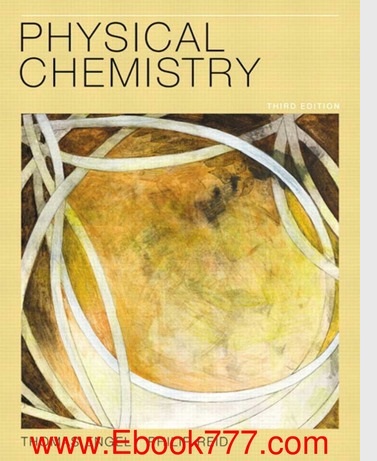 Physical Chemistry - 3rd Edition by Thomas Engel and Rhillip Reid
This widely used textbook teaches the fundamental concepts of Physical Chemistry and also the textbook has sections
that introduce cutting-edge research at the time this 3rd edition was published in 2013. The emphasis is to teach Physical chemistry
by linking the core concepts to practical uses. The diagrams/graphs/pictures throughout this textbook are in colour and are
excellent. The typset is easy to read. Equations are in colour. Each chapter has a multitude of examples with
worked solutions and also a large number of end-of-chapter exercises/problems. Answers to some of the end-of-chapter
exercises/problems are given at the end of the textbook. This textbook has been very well written.
Physical Chemistry - 3rd Edition by Thomas Engel and Rhillip Reid
This widely used textbook teaches the fundamental concepts of Physical Chemistry and also the textbook has sections
that introduce cutting-edge research at the time this 3rd edition was published in 2013. The emphasis is to teach Physical chemistry
by linking the core concepts to practical uses. The diagrams/graphs/pictures throughout this textbook are in colour and are
excellent. The typset is easy to read. Equations are in colour. Each chapter has a multitude of examples with
worked solutions and also a large number of end-of-chapter exercises/problems. Answers to some of the end-of-chapter
exercises/problems are given at the end of the textbook. This textbook has been very well written.
_______________________________________________________________________________________________________
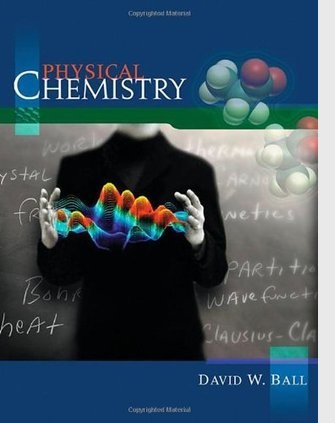 Physical Chemistry by David Ball
This textbook that teaches Physical Chemistry is also very well written and is also widely used. This textbook also
has a multitude of worked solutions to examples in every chapter and a large number of end-of-chapter exercises in every chapter, however,
in this textbook answers are given to MOST end-of-chapter exercises. The diagrams throughout the textbook that provide a visual
display of core concepts are excellent. The author assumes that the student has a knowledge of differential and integral calculus.
Physical Chemistry by David Ball
This textbook that teaches Physical Chemistry is also very well written and is also widely used. This textbook also
has a multitude of worked solutions to examples in every chapter and a large number of end-of-chapter exercises in every chapter, however,
in this textbook answers are given to MOST end-of-chapter exercises. The diagrams throughout the textbook that provide a visual
display of core concepts are excellent. The author assumes that the student has a knowledge of differential and integral calculus.
_______________________________________________________________________________________________________
_______________________________________________________________________________________________________
Molecular Quantum Mechanics - 4th Edition by Aitkens and Friedman
This textbook is teaching topic that is abstract both conceptualy and mathematically. However, for
the student who is proficient in calculus, this text is relatively easy to follow. Each chapter has worked problems
that provide insight into the concepts; the diagrams/pictures are excellent and there are end-of-chapter problems and most
importantly there are answers to most of the end-of-chapter problems at the end of the textbook.
_______________________________________________________________________________________________________
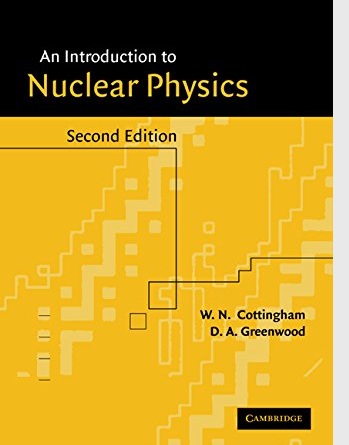 Introduction to Nuclear Physics - 2nd Edition by W. Cottingham and D. Greenwood
This introductory textbook in this specialized branch of physics has many features that make it an outstanding textbook and student
resource. The textbook begins by explaining all the elementary particles and the units of mass and energies used in nuclear physics. Then
the textbook moves onto teach nuclear masses; nuclear sizes; nuclear models; Ground-State properties of nuclei; nuclear fission processes; power from
nuclear fission; nucear fusion; nucleo-synthesis in stars and much more. Each chapter has a set of end-of-chapter problems and answers to
ALL end-of-chapter exercises are at the end of the book
Introduction to Nuclear Physics - 2nd Edition by W. Cottingham and D. Greenwood
This introductory textbook in this specialized branch of physics has many features that make it an outstanding textbook and student
resource. The textbook begins by explaining all the elementary particles and the units of mass and energies used in nuclear physics. Then
the textbook moves onto teach nuclear masses; nuclear sizes; nuclear models; Ground-State properties of nuclei; nuclear fission processes; power from
nuclear fission; nucear fusion; nucleo-synthesis in stars and much more. Each chapter has a set of end-of-chapter problems and answers to
ALL end-of-chapter exercises are at the end of the book
_______________________________________________________________________________________________________
Atomic Physics - c 2005 by Christopher Foot
This textbook, published by Oxford University Press in England has been written for an undergraduate course in atomic physics.
This is an exceptionally well written textbook with mathematical derivations that are relatively easy to follow. The diagrams
throughout the textbook are excellent. The author begins by providing insight into early atomic physics including the Einstein A and B coefficients
and the observation of the Zeeman effect. There are many energy level diagrams throughout the textbook that show allowed transitions; expecially
useful for the student who wants to understand laser action in gases and crystals. The author provides insight into well known experiments in
atomic physics and there are novel topics included such as Laser Cooling / trapping and Laser Spectroscopy. The textbook has end-of-chapter
problems and there is a solutions manual for the textbook so that the student can check they have arrived at the correct answer.
_______________________________________________________________________________________________________
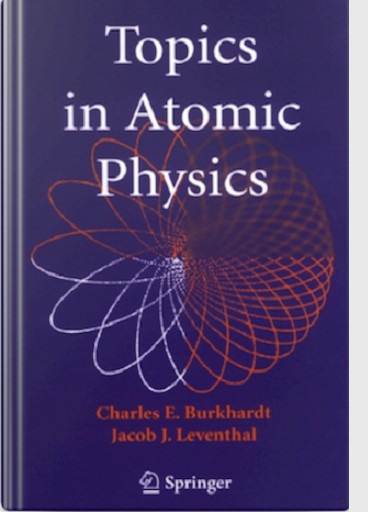 Topics in Atomic Physics - c 2006 by Charles Burkhardt and Jacob Leventhal
This textbook teaches Atomic Physics in mathematical detail. There are many proofs and derivations that are
difficult to find in other texts. It is an excellent textbook for students who will be researching specialized brances of Science
and Engineering that uss Atomic Physics. There are about 80 end-of-chapter problems with all answers given at the end of the book.
The typeset used for the book is excellent .....and the derivations are clear and easy to follow
Topics in Atomic Physics - c 2006 by Charles Burkhardt and Jacob Leventhal
This textbook teaches Atomic Physics in mathematical detail. There are many proofs and derivations that are
difficult to find in other texts. It is an excellent textbook for students who will be researching specialized brances of Science
and Engineering that uss Atomic Physics. There are about 80 end-of-chapter problems with all answers given at the end of the book.
The typeset used for the book is excellent .....and the derivations are clear and easy to follow
_______________________________________________________________________________________________________
_____________________________________________________________________________________________________________________________
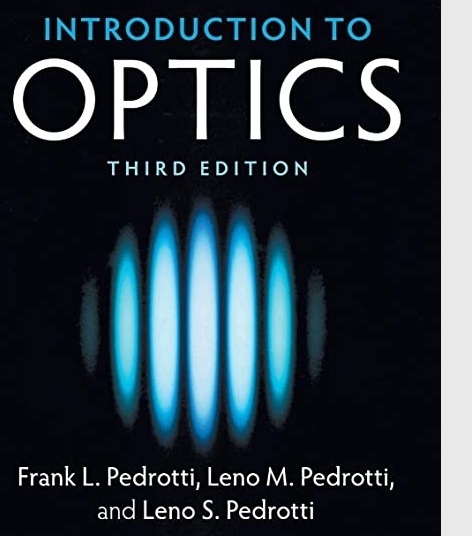 Introduction to Optics- 3rd Edition by Pedrotti and Pedrotti
This is a widely used textbook that provides a comprehensive teaching of both Geometrical and
Wave optics. This textbook is especially useful for the student who wants to gain an understanding of
the design of optical components; the major aspect of this textbook that makes it very useful are the end-of-chapter
problems which are very practical for the student to gain insight into the design and use of optical components.
All the formula used in the textbook are first derived. The textbook asumes that the student is proficient
in calculus as most of the formula are derived by calculus. Each chapter has worked problems and also there are
a large number of end-of-chapter problems with answers to ALL end-of-chapter problems given at the end of the
textbook.
Introduction to Optics- 3rd Edition by Pedrotti and Pedrotti
This is a widely used textbook that provides a comprehensive teaching of both Geometrical and
Wave optics. This textbook is especially useful for the student who wants to gain an understanding of
the design of optical components; the major aspect of this textbook that makes it very useful are the end-of-chapter
problems which are very practical for the student to gain insight into the design and use of optical components.
All the formula used in the textbook are first derived. The textbook asumes that the student is proficient
in calculus as most of the formula are derived by calculus. Each chapter has worked problems and also there are
a large number of end-of-chapter problems with answers to ALL end-of-chapter problems given at the end of the
textbook.
_______________________________________________________________________________________________________
 Elements of Photonics Volume 2 by Keigo IIzuka
This textbook Elements of Photonics Volume 2 published in 2002 provides a discussion of the basics
of Optical Fibers; Communication by Optical Fibers; the principles of Lasers including Solid-State Lasers;
Chemical Lasers; Semiconducor Lasers and more. Each chapter has a selection of end-of-chpater problems and there
are worked solutions to ALL these problems at the end of the textbook. The textbook teaches by detailed analysis
Optical-waveguides; Light-detecting devices (PIN Photo-diodes); Solid-State and Semiconductor lasers; Fiber-Optical
Communications and more. One unique aspect of this textbook os how
the author derives all the equations; the derivations are clear and easy to follow. Excellent diagrams appear
throughout the textbook. The author assumes that the reader is proficient in calculus
Elements of Photonics Volume 2 by Keigo IIzuka
This textbook Elements of Photonics Volume 2 published in 2002 provides a discussion of the basics
of Optical Fibers; Communication by Optical Fibers; the principles of Lasers including Solid-State Lasers;
Chemical Lasers; Semiconducor Lasers and more. Each chapter has a selection of end-of-chpater problems and there
are worked solutions to ALL these problems at the end of the textbook. The textbook teaches by detailed analysis
Optical-waveguides; Light-detecting devices (PIN Photo-diodes); Solid-State and Semiconductor lasers; Fiber-Optical
Communications and more. One unique aspect of this textbook os how
the author derives all the equations; the derivations are clear and easy to follow. Excellent diagrams appear
throughout the textbook. The author assumes that the reader is proficient in calculus
_______________________________________________________________________________________________________
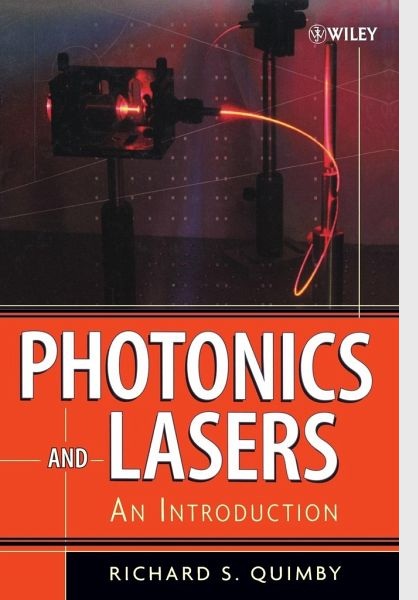 Photonics and Lasers by Richard Quimby
This would be one of the best textbooks written on this subject of Photonics and Lasers;
The concepts are excellently explained and the diagrams are excellent. Also, the author provides in-depth
analysis of how to design various photonic devices. Each chapter contains several problems with worked
solutions that demonstrate the concepts. The author derives all equations he uses and his derivations are clear
and easy to follow. The author assumes a knowledge of magnetism and Modern Physics and that the student is proficient
in differential and integral calculus. There is however one negative issue with this textbook; The author
has included a large set of end-of-chapter problems for each of the chapters but answers are NOT included anywhere in
the textbook. There is a lecturers Manual that accompanies this textbook that has answers to all the
end-of-chapter problems. If I'm able to get a copy then I'll add it below
Photonics and Lasers by Richard Quimby
This would be one of the best textbooks written on this subject of Photonics and Lasers;
The concepts are excellently explained and the diagrams are excellent. Also, the author provides in-depth
analysis of how to design various photonic devices. Each chapter contains several problems with worked
solutions that demonstrate the concepts. The author derives all equations he uses and his derivations are clear
and easy to follow. The author assumes a knowledge of magnetism and Modern Physics and that the student is proficient
in differential and integral calculus. There is however one negative issue with this textbook; The author
has included a large set of end-of-chapter problems for each of the chapters but answers are NOT included anywhere in
the textbook. There is a lecturers Manual that accompanies this textbook that has answers to all the
end-of-chapter problems. If I'm able to get a copy then I'll add it below
_______________________________________________________________________________________________________
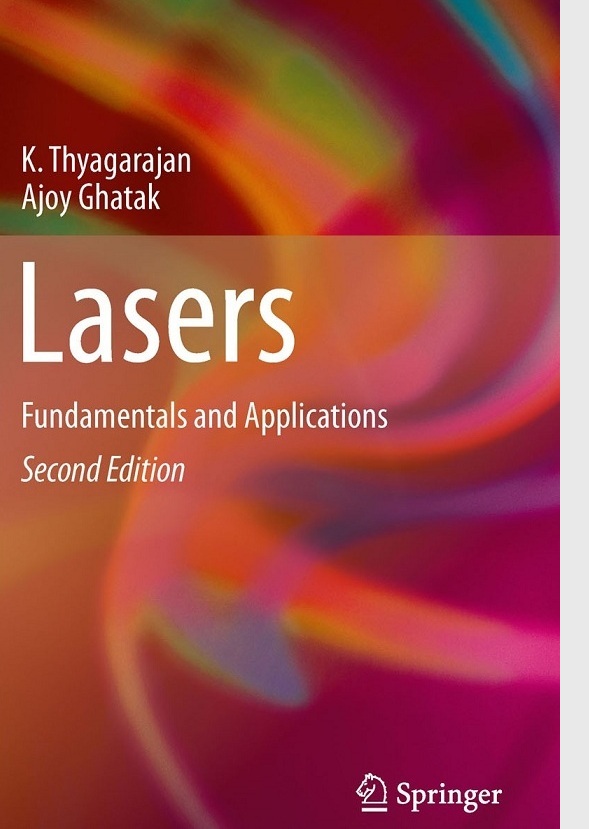 Lasers: Fundamentals and Applications - 2nd Edition by K. Thyagarajan and Ajoy Ghatak
This book was first published in 1981 as Lasers; Theory and Applications and this revised edition was published
in 2010 This edition is now a 'Textbook' containing both the theory behind the operation of the Laser and detailed descriptions of significant
applications of Lasers. This textbook contains many fundamental derivations intrinsic to lasers and these derivations are explained in a
clear and concise manner. The textbook begins by teaching wave-optics; diffraction; interference; The Schrodinger equation; The Einstein
coefficients; The Threshold condition and more. At the end of the textbook there are copies of Nobel lectures given by the Pioneers of the
laser. Each chapter ends with a set of problems.....but NO answers are given. This is however and exceptional book because of the clarity
of the many derivations
Lasers: Fundamentals and Applications - 2nd Edition by K. Thyagarajan and Ajoy Ghatak
This book was first published in 1981 as Lasers; Theory and Applications and this revised edition was published
in 2010 This edition is now a 'Textbook' containing both the theory behind the operation of the Laser and detailed descriptions of significant
applications of Lasers. This textbook contains many fundamental derivations intrinsic to lasers and these derivations are explained in a
clear and concise manner. The textbook begins by teaching wave-optics; diffraction; interference; The Schrodinger equation; The Einstein
coefficients; The Threshold condition and more. At the end of the textbook there are copies of Nobel lectures given by the Pioneers of the
laser. Each chapter ends with a set of problems.....but NO answers are given. This is however and exceptional book because of the clarity
of the many derivations
_______________________________________________________________________________________________________
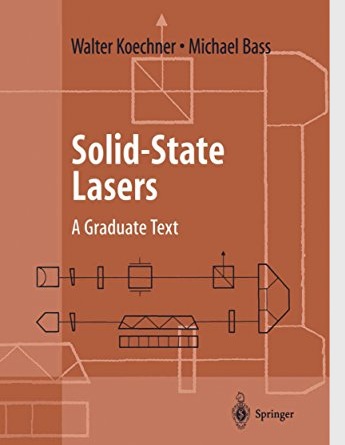 Solid State Lasers: A Graduate Text - c 2003 by Walter Koechner and Michael Bass
This college textbook describes the theory, operating characteristics, and design features of solid-state lasers. The book is
intended for students who want to familiarize themselves with solid-state lasers beyond the level of a general textbook. Although the book
is aimed at students who are thinking of entering this fascinating field, it might also be used by practicing scientists and engineers who are
changing their technical direction and want to learn more about this particular class of lasers. After studying the material presented in this
book, the reader should be able to follow the scientific and technical literature and have an understanding of the basic principles and engineering
issues of solid-state lasers, as well as an appreciation of the subtleties, richness of design, and operating possibilities afforded by these systems.
excerpt from the preface given at the beginning of the textbook
Solid State Lasers: A Graduate Text - c 2003 by Walter Koechner and Michael Bass
This college textbook describes the theory, operating characteristics, and design features of solid-state lasers. The book is
intended for students who want to familiarize themselves with solid-state lasers beyond the level of a general textbook. Although the book
is aimed at students who are thinking of entering this fascinating field, it might also be used by practicing scientists and engineers who are
changing their technical direction and want to learn more about this particular class of lasers. After studying the material presented in this
book, the reader should be able to follow the scientific and technical literature and have an understanding of the basic principles and engineering
issues of solid-state lasers, as well as an appreciation of the subtleties, richness of design, and operating possibilities afforded by these systems.
excerpt from the preface given at the beginning of the textbook
_______________________________________________________________________________________________________
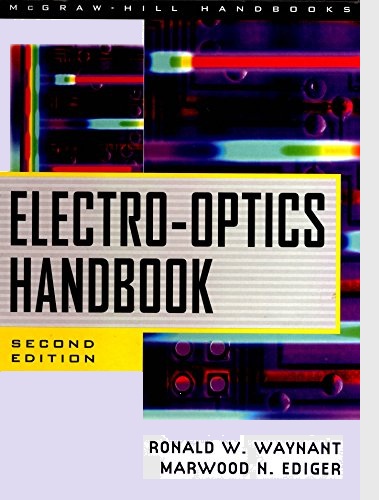 Electro-Optics Handbook 2nd Edition by Ronald Waynant and Marwood Ediger
This "Electro-Optics" Handbook ( first published in 1994 and this second edition published in 2000 )
is a reference book consisting of 29 chapters; Each Chapter is an
"Introductory" artice on a specialized branch of electro-Optics written by experts in the specialized branch.
Each chapter provides a detailed analysis with diagrams, graphs, and references. A few of the chapters give
the materials and teach the basics of design of electro-optical systems and devices. The Handbaook begins with
several chapters on different types of gas and solid-state lasers and then onto Semiconductor lasers; Free-electron Lasers;
Ultra-Short Laser Pules; Optical Fibers; Phase-Conjugation ; Detectors; Holography; Laser-Spectroscopy and more
Electro-Optics Handbook 2nd Edition by Ronald Waynant and Marwood Ediger
This "Electro-Optics" Handbook ( first published in 1994 and this second edition published in 2000 )
is a reference book consisting of 29 chapters; Each Chapter is an
"Introductory" artice on a specialized branch of electro-Optics written by experts in the specialized branch.
Each chapter provides a detailed analysis with diagrams, graphs, and references. A few of the chapters give
the materials and teach the basics of design of electro-optical systems and devices. The Handbaook begins with
several chapters on different types of gas and solid-state lasers and then onto Semiconductor lasers; Free-electron Lasers;
Ultra-Short Laser Pules; Optical Fibers; Phase-Conjugation ; Detectors; Holography; Laser-Spectroscopy and more
_______________________________________________________________________________________________________
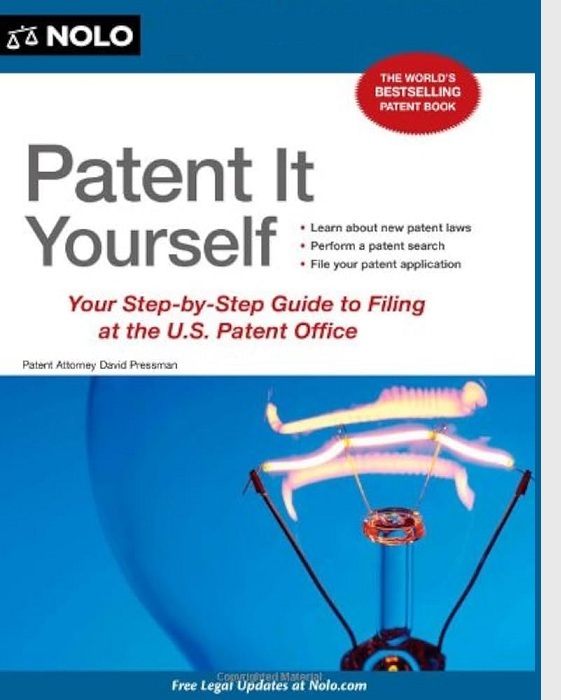 Patent it Yourself - 13th Edition - 2008 by David Pressman
For the Graduate Student who is undertaking research and development in Science or Engineering
and who is looking to Patent a novel method, apparatus, chemical compound etc, then Patent it Yourself by Patent
Attorney David Pressman is the best known reference and Guide that explains the United States Patening process......
which is a highly evolved patenting process. The author has decades of experience as a Patent Attorney. He explains
the different types of patents and discusses many issues the inventor should consider before proceeding. After then
he provides all the essential information that an inventor needs to know to firstly; prepare a patent application and
then; go through the patent application process. At the end of the Book are 35 essential forms ....this edition was
published in 2008 so some of the forms could be out of date.
Patent it Yourself - 13th Edition - 2008 by David Pressman
For the Graduate Student who is undertaking research and development in Science or Engineering
and who is looking to Patent a novel method, apparatus, chemical compound etc, then Patent it Yourself by Patent
Attorney David Pressman is the best known reference and Guide that explains the United States Patening process......
which is a highly evolved patenting process. The author has decades of experience as a Patent Attorney. He explains
the different types of patents and discusses many issues the inventor should consider before proceeding. After then
he provides all the essential information that an inventor needs to know to firstly; prepare a patent application and
then; go through the patent application process. At the end of the Book are 35 essential forms ....this edition was
published in 2008 so some of the forms could be out of date.
_______________________________________________________________________________________________________
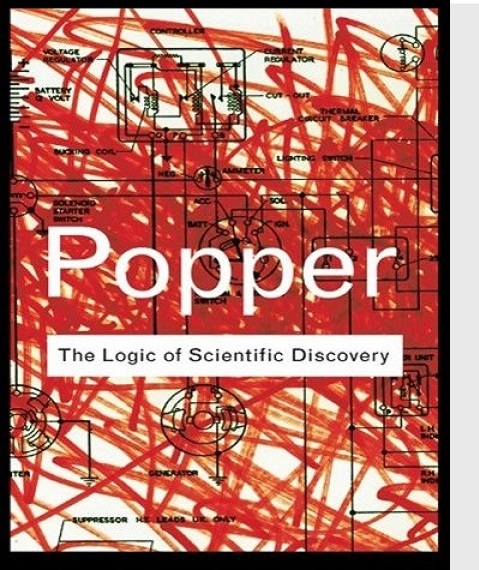 The Logic of Scientific Discovery -first published in 1959 by Karl Popper
Described by the philosopher A.J. Ayer as a work of 'great originality and power'...... this book revolutionized contemporary thinking on science and
knowledge. Ideas such as the now legendary doctrine of 'falsificationism' electrified the scientific community, influencing even working scientists,
as well as post-war philosophy. This astonishing work ranks alongside The Open Society and Its Enemies as one of Popper's most enduring books
and contains insights and arguments that demand to be read to this day.
The Logic of Scientific Discovery -first published in 1959 by Karl Popper
Described by the philosopher A.J. Ayer as a work of 'great originality and power'...... this book revolutionized contemporary thinking on science and
knowledge. Ideas such as the now legendary doctrine of 'falsificationism' electrified the scientific community, influencing even working scientists,
as well as post-war philosophy. This astonishing work ranks alongside The Open Society and Its Enemies as one of Popper's most enduring books
and contains insights and arguments that demand to be read to this day.
_______________________________________________________________________________________________________
_____________________________________________________________________________________________________________________________
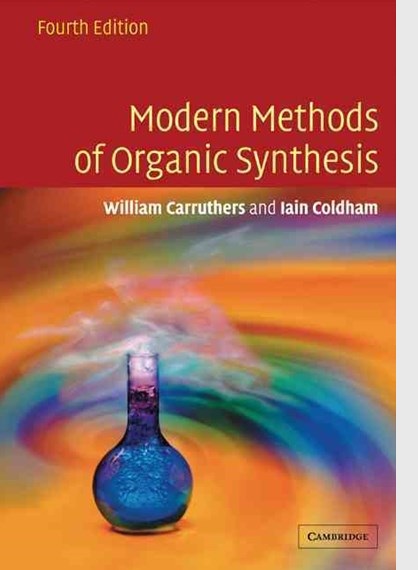 Modern Methods of Organic Synthesis by William Carrthers and Iain Coldham
This is a widely used textbook that shows many of the reactions used in Organic Chemistry.
The vast number of Organic Reactions cannot be covered in a textbook so the authors have used a criteria to select
reactions to show. As a textbook it is very valuable in the way the authors provide insight into the many
Organic reactions they've shown. Also this textbook has end-of-chapter problems and answers to all of the
end-of-chpater problems are given at the end of the textbook
Modern Methods of Organic Synthesis by William Carrthers and Iain Coldham
This is a widely used textbook that shows many of the reactions used in Organic Chemistry.
The vast number of Organic Reactions cannot be covered in a textbook so the authors have used a criteria to select
reactions to show. As a textbook it is very valuable in the way the authors provide insight into the many
Organic reactions they've shown. Also this textbook has end-of-chapter problems and answers to all of the
end-of-chpater problems are given at the end of the textbook
_______________________________________________________________________________________________________
 Introduction to Spectroscopy by Pavia, Lampman, Kriz, Vyvyan
This widely used textbook begins by explaining the basic principles of infrared spectroscopy
and also explains wavenumbers and then moves onto to teach the basic concepts of NMR spectroscopy and then onto
specialized topics in NMR spectroscopy. The diagrams and spectrum charts throughout the textbook are
excellent and the book is written clearly and concisely. Each chapter has a set of end-of-chapter
problems and answers to the problems are at the end of the book.
Introduction to Spectroscopy by Pavia, Lampman, Kriz, Vyvyan
This widely used textbook begins by explaining the basic principles of infrared spectroscopy
and also explains wavenumbers and then moves onto to teach the basic concepts of NMR spectroscopy and then onto
specialized topics in NMR spectroscopy. The diagrams and spectrum charts throughout the textbook are
excellent and the book is written clearly and concisely. Each chapter has a set of end-of-chapter
problems and answers to the problems are at the end of the book.
_______________________________________________________________________________________________________
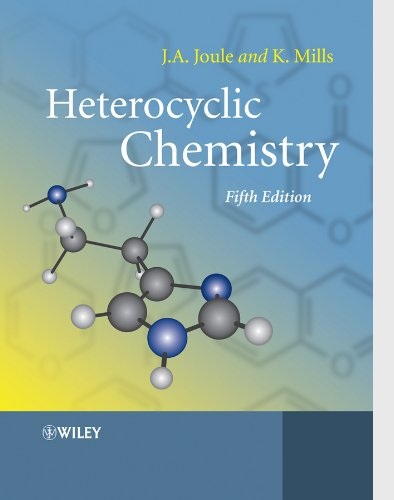 Heterocyclic Chemistry by John A Joule and Keith Mills
This is an excellent textbook and reference book that provides a comprehensive coverage of
this specialized branch of organic chemistry. It has number of features for which it is an excellent
student resource and reference book; The authors provide insight into a huge number of reacions involving
heterocyclic compounds and the text also contains over 4000 references including many references to original work.
Each chapter ends with a number of exercises; there are no answers given in the book.....however a pdf with the
end-of-chapter answers is provided below
Heterocyclic Chemistry by John A Joule and Keith Mills
This is an excellent textbook and reference book that provides a comprehensive coverage of
this specialized branch of organic chemistry. It has number of features for which it is an excellent
student resource and reference book; The authors provide insight into a huge number of reacions involving
heterocyclic compounds and the text also contains over 4000 references including many references to original work.
Each chapter ends with a number of exercises; there are no answers given in the book.....however a pdf with the
end-of-chapter answers is provided below
_______________________________________________________________________________________________________
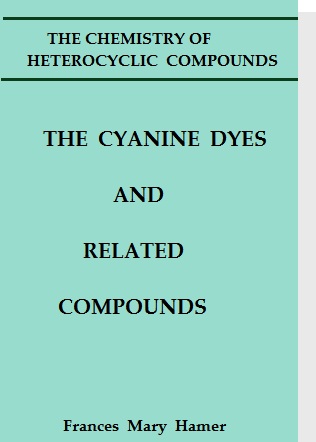 Cyanine Dyes and Related Compounds c 1964 by Frances Mary Hamer
The Chemistry of Heterocyclic Compounds is one of the most complex branches of organic chemistry.
It is equally interesting for it's theoretical implications, for the diversity of it's synthetic procedures, and for the
physiological and industrial significance of Heterocyclic Compounds .......Excerpt from the Introduction given by Arnold
Weissberger Eastman Kodak research Laboratories in 1964 ------ This book teaches the Chemistry, the Synthesis
and also the history of the development of Cyanine Dyes that are used as sensitizers for photographic film. This is an
excellent reference book for the student who is studying Heterocyclic Chemistry to gain insight into one practical use of this
branch of Organic Chemistry
Cyanine Dyes and Related Compounds c 1964 by Frances Mary Hamer
The Chemistry of Heterocyclic Compounds is one of the most complex branches of organic chemistry.
It is equally interesting for it's theoretical implications, for the diversity of it's synthetic procedures, and for the
physiological and industrial significance of Heterocyclic Compounds .......Excerpt from the Introduction given by Arnold
Weissberger Eastman Kodak research Laboratories in 1964 ------ This book teaches the Chemistry, the Synthesis
and also the history of the development of Cyanine Dyes that are used as sensitizers for photographic film. This is an
excellent reference book for the student who is studying Heterocyclic Chemistry to gain insight into one practical use of this
branch of Organic Chemistry
_______________________________________________________________________________________________________
_______________________________________________________________________________________________________
Resources for Graduate Students in Applied Physics and Chemistry can be obtained from the SPIE . The e-books and research-letters published by the SPIE are NOT free. They can be obtained by purchasing them from the SPIE Bookstore in the United States The link to the SPE Bookstore is embedded in the picture below.